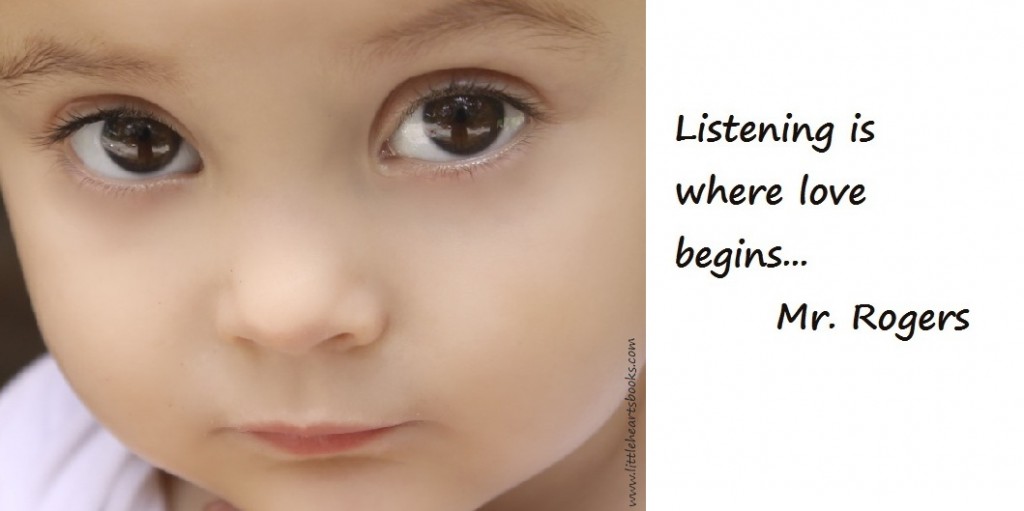‘Encouraging Safe Negative Emotional Expression (i.e. Stopping the Peeing, Spitting & Kicking)’ by Guggie Daly – Friends of L.R.Knost Rock the Guest Posts while She Battles Cancer
 A common stage that can start around age 2 but typically peaks by age 4 is the passive aggressive communication of negative feelings. This stage occurs on its own as a normal milestone because the child needs to develop verbal skills and emotional intelligence. But, for some children, the stage can be especially difficult due to various factors.
A common stage that can start around age 2 but typically peaks by age 4 is the passive aggressive communication of negative feelings. This stage occurs on its own as a normal milestone because the child needs to develop verbal skills and emotional intelligence. But, for some children, the stage can be especially difficult due to various factors.
First, if the child has been emotionally invalidated frequently by other caregivers or cherished peers, this behavior might become a way to passively share emotions or cry out for help, or even attempt to take back some semblance of control. Watch out for common invalidating comments. Take steps to remind the adult that your child is learning and respect is required. Briefly but firmly reassure the child when invalidation occurs. Some examples of emotional invalidation:
Oh, you’re ok! Stop crying about it.
Hey! There’s no reason to be angry about that, quit it.
Oh, you’re being a scaredy cat. That’s not scary at all.
Why are you crying over such a silly thing? Don’t be a baby.
I don’t care if that makes you angry. That doesn’t matter.
I can’t stand when you cry like that. Knock it off already.
Your brother isn’t scared of the dark. Why don’t you be like him?
Besides directly hurting the child, invalidating situations deprive the child of an opportunity to practice emotional processing and emotional regulation. It’s a loss of skill development. Try whenever possible to defend your child from invalidation.
Second, if the child is experiencing any language difficulties or delays, or other circumstances and conditions that interfere with easy verbal communication such as hearing difficulties, autism, hyperactivity, etc, then this stage can persist because it is simply easier to communicate physically. Or it might be impossible from the child’s perspective to communicate in ways society deems appropriate. In these cases, removing the obstacle when possible and working on coping skills can help create a bridge from the physical outbursts to safer expression.
When your child only expresses negative emotions in your presence
Many parents report that their children do not act out at school, daycare, the other parent’s home, in front of peers, etc. But, seemingly the moment they get home, suddenly the children are throwing things, screaming, spitting, wetting their pants…why the sudden change?
If your child only expresses negative emotions in your presence, or in specific areas such as only at home, this is a sign that she feels safest with you. It’s not a bad sign. It doesn’t mean she’s taking advantage of you or that you’re too soft on her. On the contrary, it means she has big emotions boiling up inside her and she only trusts you to see them.
Think about it. If you’re really stressed out about something you feel is perhaps slightly embarrassing (read: invalidating or shamed by others) you probably keep it hidden. You don’t cry your eyes out at work. You don’t curse and go on about someone who hurt you at the playground. You wait until you’re home and with a safe person to finally let go of your feelings. Children do this, too. And if your child is doing this frequently, it could be a sign that he feels shamed, judged, or invalidated. Remember this when you are facing frustrating behavior, so that you can respond in a way that builds the trust while developing the communication skills.
When your child begins to use emotional outbursts to exert control
Children who feel stifled emotionally can feel powerless. This can cause intense feelings of resentment and anxiety. The child is stuck experiencing what feels like a very large crisis, but the adults around him ignore it or punish him if he lets them know about it. He’s new to the world and has very few skills for handling it, so he’s lost in himself and lost to others.
As he begins to act out, he comes to find that certain ways of expressing his emotion not only feel good, letting off steam and relieving that anxiety inside him, but might also cause a reaction in others. If it feels good and gets him what he wants, it must be a good idea to keep using it!
Suddenly, you have a child who spits on you when she’s angry or pees her pants when she’s rejected. Who throws toys at children at the park when she feels left out or pretends to choke on food she doesn’t like.
Emotions don’t just melt away. They will find their way out, and in children who haven’t developed healthy emotional skills, they will come out in ways we dislike. Ways that might hurt others or cause negative reactions. Ways that tempt us to rain down punishment and consequences.
If your child is falling back on crude emotional expression to get your attention, it’s a sign that she needs your help, not punishment at this time. No, I’m not saying to condone the behavior or to go all wishy-washy. I’m warning against hyper focusing on the negative behavior to the point that skill-building is squeezed out. Even if the child is punished enough to be convinced to stop the emotional outburst, she still needs to learn healthy ways to process and express her emotions. The need is still there. Start processing with her.
Great. So how is this done?
Let’s use a real life example of a 3 year old who is fully potty trained and does not wet her pants at preschool or with her father. But, she frequently wets her pants when with her mother. Not only does this warn us that she feels safe in her mother’s presence and that she has some big emotions building up inside her, but the child has also begun to use the emotional outbursts to cause reactions in others.
For example, when the mother walked away from the 3 year old to care for the baby, the 3 year old wet her pants.
At this point, a lot of different approaches could be taken ranging from shaming and punishment to completely ignoring it and remaining emotionless while cleaning up the mess. These are merely superficial responses, however, and do nothing to encourage her to develop emotional skills.
Let’s say the mother has just come back from caring for the baby and the 3 year old is sitting on the floor with wet pants and with an angry and slightly rejected expression on her face. What does the mom do for her?
She gets down on one knee, moving close to her, making eye contact and making physical contact such as by touching her arm gently. While keeping physical and eye contact, she begins assessing the situation.
Hey. I see that you peed in your pants. You must be feeling pretty embarrassed right now. Can you use your words to tell me why you peed your pants? Pause for response. You were feeling angry because I left you to help the baby, huh. It made your heart hurt? Pause for response.
You know, it’s okay to feel angry. That’s a strong feeling, but it doesn’t make you a bad person. Everyone feels angry sometimes. When I feel angry, it makes my stomach squeeze. What does it feel like for you? Pause for response.
Next time when you feel angry, I want you to use your words to tell me. Say, “I’m angry!” Let’s try it right now. Ready? Tell me! Pause for response. Remember, instead of peeing your pants, it’s okay to tell me that you’re angry. I’ll always listen to you.
And if you begin to recognize individual triggers, briefly remind her before they happen:
I’m going to focus on caring for your sister right now. Remember, if you feel alone, come grab my hand and tell me instead of peeing your pants.
I’m going to leave the room to make dinner. If you feel scared inside, come and get me, ok? Remember to keep your pants dry.
Tonight, we’re going to be very busy with the baby at the park. If you start to feel angry, be sure to tell me with your big girl words! I will listen.
Remember to keep it as simple or long as needed, pausing when needed and following cues to go where the conversation leads you. As children begin to realize how much connection they can make with words, lots of thoughts might tumble out in little situations like this. Try to listen intently and to provide a safe place for those emotions to come out.
Guggie Daly, taking a break from her studies in neuroscience to care for her four young children, hopes to share relevant, up to date information with other parents so that they can take advantage of foresight and not live with hindsight. You can find more information on her blog at Guggie Daly: Empowering Information and on Facebook at The Guggie Daily.
Related posts:
 Award-winnning author, L.R.Knost, is the founder and director of the children's rights advocacy and family consulting group, Little Hearts/Gentle Parenting Resources, and Editor-in-Chief of Holistic Parenting Magazine. Books by L.R.Knost include Whispers Through Time: Communication Through the Ages and Stages of Childhood ; Two Thousand Kisses a Day: Gentle Parenting Through the Ages and Stages ; The Gentle Parent: Positive, Practical, Effective Discipline ; and Jesus, the Gentle Parent: Gentle Christian Parenting the first four books in the Little Hearts Handbook gentle parenting series, and children’s picture books Petey’s Listening Ears and the soon-to-be-released Grumpykins series.
Award-winnning author, L.R.Knost, is the founder and director of the children's rights advocacy and family consulting group, Little Hearts/Gentle Parenting Resources, and Editor-in-Chief of Holistic Parenting Magazine. Books by L.R.Knost include Whispers Through Time: Communication Through the Ages and Stages of Childhood ; Two Thousand Kisses a Day: Gentle Parenting Through the Ages and Stages ; The Gentle Parent: Positive, Practical, Effective Discipline ; and Jesus, the Gentle Parent: Gentle Christian Parenting the first four books in the Little Hearts Handbook gentle parenting series, and children’s picture books Petey’s Listening Ears and the soon-to-be-released Grumpykins series.
Spare the Rod: The Heart of the Matter
[Excerpt reprinted from Jesus, the Gentle Parent: Gentle Christian Parenting by L.R.Knost. Two Thousand Kisses a Day: Gentle Parenting Through the Ages and Stages; Whispers Through Time: Communication Through the Ages and Stages of Childhood; and The Gentle Parent: Positive, Practical, Effective Discipline by L.R.Knost also available on Amazon and through other major retailers.]
~~~~~~~~~~~~~~
“Your rod and your staff, they comfort me…”
Psalm 23:4
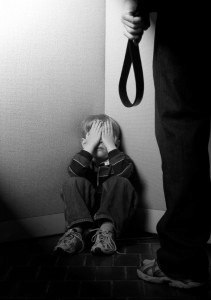 One of the hot-button issues when it comes to discipline and children is, of course, spanking, and the more Christian and conservative the audience, the more hot the debate becomes. And yet there are no verses in the New Testament that support spanking, smacking, whipping, or otherwise hitting children.
One of the hot-button issues when it comes to discipline and children is, of course, spanking, and the more Christian and conservative the audience, the more hot the debate becomes. And yet there are no verses in the New Testament that support spanking, smacking, whipping, or otherwise hitting children.
In the Old Testament there are a total of five verses that have been interpreted to encourage, or even command, the use of physical punishment on children. All five of those verses are in the book of Proverbs. The word ‘proverb’ in the original Hebrew text is mashal and defined as a parable, prophetic and figurative discourse, symbolic poem, pithy maxim (i.e.a collection of wise metaphors and adages).
Of interest is that ancient Hebrew had many words for children, each denoting a specific stage of childhood and many a specific gender:
yeled or yaldah – newborn boy or girl
yonek or yanak – nursling baby
olel – nursling baby who also eats food (translated ‘young child’ in Lamentations 4:4 KJV)
gamal – weaned child (around 3-4 years old)
taph – young child, one who still clings to their mother
elem or almah – firm and strong, older child
na’ar (masc.) or na’arah (fem.) – independent child, young adult child (includes older adolescents and young adults)*
The word translated ‘child’ and ‘children’ in those Old Testament rod verses is na’ar, which when literally translated, means ‘young man.’
Let’s look, also, at the words translated ‘discipline’ and ‘punish’ and ‘rod’ and others:
The word muwcar is translated ‘discipline’ and means, literally, ‘verbal instruction and teaching.’ In Hebrew culture muwcar was vernacular for ‘let us reason with one another’ implying a mutual discussion for learning purposes. And towkechah is translated ‘reprove’ or ‘rebuke’ but also means ‘reason with, convince, prove, persuade.’ Neither of these words means to physically punish in any way, shape, or form.
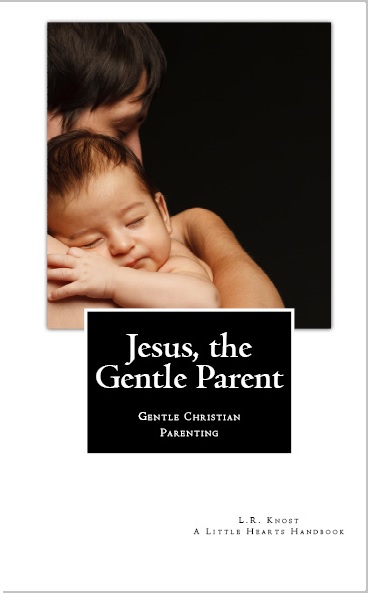 The word nakah is translated ‘punish’ in most English translations of the Bible, though its literal translation is ‘beat’ as in “The sun beat down on his head,” implying a constant presence; or ‘hit’ as when beating back an enemy or punishing a slave or criminal; or ‘smite or smitten’ which can mean ‘hit or trigger the conscience’ or ‘be favorably impressed, enticed, or entranced’ as in, “He was smitten with the idea of a new bicycle.”
The word nakah is translated ‘punish’ in most English translations of the Bible, though its literal translation is ‘beat’ as in “The sun beat down on his head,” implying a constant presence; or ‘hit’ as when beating back an enemy or punishing a slave or criminal; or ‘smite or smitten’ which can mean ‘hit or trigger the conscience’ or ‘be favorably impressed, enticed, or entranced’ as in, “He was smitten with the idea of a new bicycle.”
The word shebet is translated ‘rod’ and means, literally, ‘shepherd’s crook’ and, in Hebrew culture, was a means not only of guiding and protecting sheep, but also a symbol of leadership. The markings on the head of the shebet often identified the head of a family or tribe, letting everyone know who to go to for guidance and protection. The shebet, then, denotes wisdom, leadership, and protection.
The word muwth is translated ‘die’ and has several meanings related to death including ‘to follow a path of destruction.’
The word ‘ivveleth is translated ‘foolishness’ but also means ‘inexperience, naivety, silliness.’
And, finally, the Hebrew word sane is translated ‘hate’ and yet means ‘does not love’ or ‘does not choose or show a preference for.’
When we read the five ‘rod’ verses with the literal translations of the words above, the meanings become more clear.
So Proverbs 13:24 reads:
“He who spares his rod wisdom, leadership, protection hates does not love, does not choose or show a preference for his son, but he who loves him disciplines offers verbal instruction and teaching to him promptly.”
Proverbs 22:15 reads:
“Foolishness Naivety, silliness, inexperience is bound up in the heart of a child young man; the rod of correction wisdom, leadership, protection will drive it far from him.”
Proverbs 29:15 reads:
“The rod Wisdom, leadership, protection and rebuke reasoning with, convincing, proving, persuading give wisdom, but a child young man left to himself brings shame to his mother.”
And, the last two ‘rod’ verses, found in Proverbs 23:12-26 read:
“Apply your heart to instruction and your ears to words of knowledge.
Do not withhold discipline verbal instruction and teaching, reasoning together from a child young man; if you punish guide, trigger his conscience, favorably impress, entice/entrance them with the rod wisdom, leadership, protection, they will not die follow a path of destruction.
Punish Guide, trigger his conscience, favorably impress, entice/entrance them with the rod wisdom, leadership, protection and save them from death following a path of destruction.
My son, if your heart is wise, then my heart will be glad indeed; my inmost being will rejoice when your lips speak what is right.
Do not let your heart envy sinners, but always be zealous for the fear of the Lord. There is surely a future hope for you, and your hope will not be cut off.
Listen, my son, and be wise, and set your heart on the right path: Do not join those who drink too much wine or gorge themselves on meat, for drunkards and gluttons become poor, and drowsiness clothes them in rags.
Listen to your father, who gave you life, and do not despise your mother when she is old.
Buy the truth and do not sell it—wisdom, instruction and insight as well. The father of a righteous child young man has great joy; a man who fathers a wise son rejoices in him. May your father and mother rejoice; may she who gave you birth be joyful!
My son, give me your heart and let your eyes delight in my ways.”
Such a beautiful image of a father tenderly and diligently sharing his wisdom with his son, isn’t it? Clearly, applying these scriptures to small children is not in line with a literal interpretation. It actually makes more sense to apply them to the disciples, which is exactly what Jesus does with his twelve ‘sons.’
Beyond translations and interpretations, though, and of far greater import, what seems to get lost in the spanking debate is that Jesus brought grace and mercy as his methods and message for a reason. The purpose of the law in the Old Testament was to highlight the need for a Savior because humans simply cannot live perfectly.
Jesus came to fulfill the outward requirements of the law that highlighted man’s sins and replace them with an inner heart change. He demonstrated in many ways that the law (outer governance and control through fear of punishment) was no longer to be a rigid yoke with its heavy burden of cleansing and rituals and sacrifices and punishments, but instead was to be a kingdom of the heart, of mercy not sacrifice, because the sacrifice was Himself.
Jesus stopped the people from stoning the prostitute (John 8:2-11) which was a requirement in the Old Testament. (Deuteronomy 22:21-22)
Jesus healed people and traveled on the Sabbath (Matthew 12:1-14) which was punishable by death in the Old Testament. (Exodus 31:14-17 and Numbers 15:32-36)
Jesus consorted with ‘sinners’ and ate with them (Luke 15:1-2) despite the admonitions in Proverbs 13:20. (the same book in the Bible with the ‘rod’ scriptures)
Jesus showed again and again that if we accept him as our Savior, we are called to be “ministers of a new covenant—not of the letter but of the Spirit; for the letter kills, but the Spirit gives life.” (2 Corinthians 3:6)
We accept that Jesus brought a new and better way, a way of the heart, “Not on tablets of stone but on tablets of human hearts.” (2 Corinthians 3:3b), but don’t seem to want to acknowledge that better way with our children. We accept God’s grace and forgiveness for ourselves, but often don’t share those gifts with, and model them for, our children. But we are our children’s first taste of God. Is it any wonder people have such a hard time understanding grace and mercy and unconditional love when they may not have been taught those things by their earthly parents and don’t exercise them with their own children?
Through Jesus’ sacrifice, he tore open the veil dividing man from God and brought a new kingdom, a kingdom of inner governance through the Holy Spirit whose fruit is “peace, patience, kindness, goodness, faithfulness, gentleness, and self-control.” Nowhere does Jesus say to follow him except when it comes to our children. He doesn’t say to offer grace and mercy and forgiveness to everyone except our children. The Bible doesn’t tell us to show the fruit of the Spirit to everyone except our children.
If we truly believe that, based on five verses in the Old Testament with disputable translations and debatable interpretations, we are being disobedient to God’s commands if we don’t spank our children, then we must take that belief and walk it out fully.
In other words, if we must obey that supposed command, then we must obey all the other commands such as,,,
- an “eye for an eye” (Exodus 21:24) and stoning adulterers (Leviticus 20:10) …but didn’t Jesus bring forgiveness?
- we shouldn’t feed the homeless because “if a man doesn’t work, neither shall he eat” (2 Thessalonians 3:10) …but aren’t we supposed to be the heart and hands of Jesus?
- we shouldn’t give Christmas shoeboxes to prisoners’ children because “the sins of the father are visited on the children” (Exodus 20:5) …but isn’t the “kingdom of heaven made up of such as these?” (Matthew 19:14)
My point is summed up in this verse:
“For whoever keeps the whole law and yet stumbles at just one point is guilty of breaking all of it.” (James 2:10)
In other words, if you feel bound by those five verses, then you must be bound by all.
If you truly believe that those five verses have been interpreted correctly and that “spare the rod, spoil the child” (Note: There is no verse in the Bible that says ”spare the rod, spoil the child.” That phrase is actually from a satirical poem called Hudibras by Samuel Butler first published in 1662.) refers to an actual physical rod (instead of a symbol of guidance and loving correction…i.e. discipleship) and that the word used for ‘child’ refers to a toddler or small child instead of the actual linguistic translation meaning ‘young man,’ then so be it.
But do you really believe that Jesus’ New Covenant is for everyone except children? That grace, mercy, unconditional love, and forgiveness are for adults only?
The disciples made that mistake, and Jesus said to them,
“Let the little children come to me, and do not hinder them, for the kingdom of God belongs to such as these.” (Luke 18:16)
Five verses with questionable interpretations versus following Jesus’ example…no contest. [end excerpt]
…….
*Note: Hebrew is a very descriptive, picturesque (i.e. visual) language. In describing something that is out of the ordinary, words were often used to convey a deeper meaning using word pictures. That is the case with the word na’ar which means, literally, ‘independent male’ and refers to a young man, but is also used as a word picture in rare circumstances to convey an unnatural independence when referring to an infant or young child who has been ‘ripped away’ or become unnaturally ‘independent’ from the nurturing presence of a parent. This is the case with Moses as he was placed in a basket and sent away from his mother as an infant (yeled in Hebrew throughout the text of the Exodus account except for one word picture, na’ar, indicating the baby’s separation from his mother) and with Samuel who was left at the temple by his mother at a young age. In those unique instances, the word picture of a male made independent by unnatural circumstances is conveyed by the use of the word na’ar. In every other instance, na’ar literally means a male of independent age, a young man.
Related posts:
Jesus, the Gentle Parent: Gentle Christian Parenting
Tattered Tapestries: Weaving Trust Through the Chaos
Fear Doesn’t Lead to Faith: Becoming Your Child’s Safe Place
Where Did You Learn Love, Child?
Gentle Journeys: A Book Club for a New Generation
 Award-winnning author, L.R.Knost, is the founder and director of the children's rights advocacy and family consulting group, Little Hearts/Gentle Parenting Resources, and Editor-in-Chief of Holistic Parenting Magazine. Books by L.R.Knost include Whispers Through Time: Communication Through the Ages and Stages of Childhood ; Two Thousand Kisses a Day: Gentle Parenting Through the Ages and Stages ; The Gentle Parent: Positive, Practical, Effective Discipline ; and Jesus, the Gentle Parent: Gentle Christian Parenting the first four books in the Little Hearts Handbook gentle parenting series, and children’s picture books Petey’s Listening Ears and the soon-to-be-released Grumpykins series.
Award-winnning author, L.R.Knost, is the founder and director of the children's rights advocacy and family consulting group, Little Hearts/Gentle Parenting Resources, and Editor-in-Chief of Holistic Parenting Magazine. Books by L.R.Knost include Whispers Through Time: Communication Through the Ages and Stages of Childhood ; Two Thousand Kisses a Day: Gentle Parenting Through the Ages and Stages ; The Gentle Parent: Positive, Practical, Effective Discipline ; and Jesus, the Gentle Parent: Gentle Christian Parenting the first four books in the Little Hearts Handbook gentle parenting series, and children’s picture books Petey’s Listening Ears and the soon-to-be-released Grumpykins series.
The Color of Change
[Portions reprinted from The Gentle Parent: Positive, Practical, Effective Discipline by L.R.Knost. Whispers Through Time: Communication Through the Ages and Stages of Childhood and Two Thousand Kisses a Day: Gentle Parenting Through the Ages and Stages also available on Amazon and through other major retailers.]
~~~~~~~~~~~~~~~~~~~~~

So few parents today were raised peacefully and respectfully by their own parents that it’s no surprise that a big issue in the gentle parenting community is how to overcome the stumbling blocks of change. Moving from a control-based parenting style, whether you’re used to spanking or time-outs or reward charts or some combination of the three, to a connection-based parenting style is a heart and mindset change as much as it is a lifestyle change. The undeniable fact is that change is hard work. Whether you’re trying to overcome your own childhood or your own already-established parenting habits, you can expect it to get harder before it gets easier. Just like with any lifestyle change, you will hit walls along the way, and they might even knock you back a step or two. Here are five tips to help you keep calm and carry on to achieve your parenting goals:
1) Commit to no hitting or other physical expressions of anger or frustration, and let that be your starting point, the line in the sand that you absolutely won’t cross. Just like in marriage, if you don’t make a commitment, there’s nothing to keep you from straying back into old patterns.
2) Rethink your parenting role and move from trying to force or manipulate or plead or coerce or use any other tactic to try to control your child’s behavior and instead build a desire in your child to cooperate because they trust you to make good decisions and to want them to be happy and safe. Do that by taking all of that energy that’s been going into trying to control their behavior (external controls) and focusing it on trying to build your connection and modeling the behavior you want to encourage (building internal controls).
3) Examine what you’re modeling. If right now you are insisting on your own way and reacting emotionally with anger and power-plays to your child’s lack of cooperation, what are you modeling? Stubbornness and lack of emotional regulation (i.e. adult-style tantrums). If, instead, you connect with your child, engage them in creative problem-solving, and work together with them toward a resolution to whatever issue you’re having, what are you modeling? Compromise, resourcefulness, and cooperation. Definitely worthwhile life lessons!
4) Keep working on you. Remind yourself that it’s your emotions and experiences and expectations that are causing your outbursts, not your little one’s behavior. Ask yourself why you’re so upset. Let yourself explore your inner triggers. Work through that internally instead of reacting to it externally.
5) Choose a touchstone in a color that will help to keep you grounded, something to look at or hold on to when you feel yourself slipping back into old thinking and behavior patterns. It could be a necklace or bracelet or key chain in a color that captures the essence of the parent you want to be to help you stay focused as you work your way toward becoming that parent. Colors have psychological implications, so some good choices might be blue which is the color of peace and trust; turquoise which is the color of communication; pink which is the color of unconditional love; or magenta which is the color of harmony. You can also place the color around your house as a reminder of the peaceful home you’re trying to create and as a symbol of change and renewal to help you remember to stop and breathe and think before responding to your child.
Remember, it’s a huge change to go from demanding obedience to inviting cooperation, and if you are already in an adversarial pattern with your child, that process will take extra time and patience. And keep in mind that no parenting ‘works’ to change a child into an adult or into a perfect little puppet. Children are imperfect humans being raised by imperfect humans in an imperfect world, after all! But shifting your thinking from expecting, or demanding, obedience to working with your child, understanding them, connecting with them, and inviting them to cooperate (i.e. Instead of “If you don’t put your dinner dishes in the sink, you won’t get ice cream for dessert” try “Let me know when your dishes are in the sink so I can get your ice cream for you.”) is the first and most important step toward a gentler style of parenting and a more peaceful home.
*Having gentle parenting tools ready and available in your ‘toolbox’ will go a long way toward helping you to stick to your commitment to be a more gentle parent. Here are some links to practical alternatives to punishment:
Practical, Gentle, Effective Discipline
Testing the Boundaries~What’s a Parent to Do?
*Also published in The Natural Parent Magazine
Related posts:
When Children Act Out ~ Reflecting Our Emotions
Backtalk is Communication…LISTEN
Bridge Over Troubled Waters~Parenting a ‘Problem’ Child
The Taming of the Tantrum: A Toddler’s Perspective
The Thoughtful Parent’s Guide to Positive Parenting Guides
 Award-winnning author, L.R.Knost, is the founder and director of the children's rights advocacy and family consulting group, Little Hearts/Gentle Parenting Resources, and Editor-in-Chief of Holistic Parenting Magazine. Books by L.R.Knost include Whispers Through Time: Communication Through the Ages and Stages of Childhood ; Two Thousand Kisses a Day: Gentle Parenting Through the Ages and Stages ; The Gentle Parent: Positive, Practical, Effective Discipline ; and Jesus, the Gentle Parent: Gentle Christian Parenting the first four books in the Little Hearts Handbook gentle parenting series, and children’s picture books Petey’s Listening Ears and the soon-to-be-released Grumpykins series.
Award-winnning author, L.R.Knost, is the founder and director of the children's rights advocacy and family consulting group, Little Hearts/Gentle Parenting Resources, and Editor-in-Chief of Holistic Parenting Magazine. Books by L.R.Knost include Whispers Through Time: Communication Through the Ages and Stages of Childhood ; Two Thousand Kisses a Day: Gentle Parenting Through the Ages and Stages ; The Gentle Parent: Positive, Practical, Effective Discipline ; and Jesus, the Gentle Parent: Gentle Christian Parenting the first four books in the Little Hearts Handbook gentle parenting series, and children’s picture books Petey’s Listening Ears and the soon-to-be-released Grumpykins series.
The Problem with Punishment
[Reprinted from Two Thousand Kisses a Day: Gentle Parenting Through the Ages and Stages by L.R.Knost. Whispers Through Time: Communication Through the Ages and Stages of Childhood and The Gentle Parent: Positive, Practical, Effective Discipline also now available on Amazon and through other major retailers.]
~~~~~~~~~~~~~~~~~~~~~
 Want to know a dirty, little secret about punishment?
Want to know a dirty, little secret about punishment?
It doesn’t work.
Punishment may be able to control a child’s behavior temporarily while they’re small or when they are in their parents’ presence, but it cannot control the person. As with all humans, outward behavior is merely a reflection of our inner selves: our needs, our hurts, our emotional states.
While the temporary ‘payoff’ of punishment may be compliance, the need behind the behavior is never addressed and those needs merely get driven underground and often emerge later in more potentially damaging behaviors such as lying, sneaking, anger, outright rebellion, depression, aggression, addictions, etc.
In the same way that treating a brain tumor by merely taking a pain reliever doesn’t address the underlying issue, masking the symptoms of an underlying need with punishment-induced compliance doesn’t solve the problem; it intensifies it.
Want to know another dirty, little secret about punishment?
It requires constant escalation.
In order to maintain the temporary effect of controlling behavior, the punishment, or threats of punishment, must constantly be ramped up. Parents who start out with popping a tiny hand escalate to smacking a chubby little leg, then paddling a small bottom. Over time, as their children’s needs which have been driven underground emerge in ever-increasing behavioral issues, parents often find that they are resorting to yelling and threats and physical punishment more and more often.
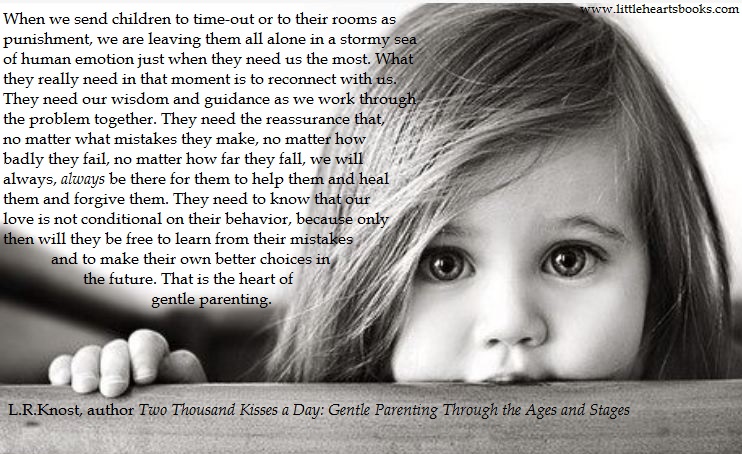 Even parents who use punishment-based parenting approaches other than physical punishment find that they must escalate and escalate to keep their children under ‘control.’ Behavior charts, time-outs, grounding, and removing privileges are some examples of non-physical punishment-based parenting. While these behavior modification techniques may be less painful to children physically, they still don’t address the underlying needs being communicated by the behavior and often are nearly as destructive to the parent/child relationship.
Even parents who use punishment-based parenting approaches other than physical punishment find that they must escalate and escalate to keep their children under ‘control.’ Behavior charts, time-outs, grounding, and removing privileges are some examples of non-physical punishment-based parenting. While these behavior modification techniques may be less painful to children physically, they still don’t address the underlying needs being communicated by the behavior and often are nearly as destructive to the parent/child relationship.
Using isolation such as time-outs or sending children to their room separates them from their source of guidance and comfort just when they need it the most and not only misses a golden opportunity to help the child learn coping mechanisms for dealing with their emotions, but also fractures the very connection that should provide the safety for expressing those emotions. Using behavior charts, removal of privileges, grounding, etc. separates children from their parents by creating an us-against-them mentality that inevitably leads to conflict instead of creating a teamwork mentality that leads to cooperation.
Here’s the thing, effective parenting and, more specifically, effective discipline, doesn’t require punishment. Equating discipline with punishment is an unfortunate, but common misconception. The root word in discipline is actually disciple which in the verb form means to guide, lead, teach, model, and encourage. In the noun form disciple means one who embraces the teaching of, follows the example of, and models their life after.
On the flip side, the root word in punishment is the Latin word punire which in verb form means to penalize, chastise, castigate, inflict harm, humiliate. There is no noun form of punire or its English equivalent, punishment.
Many of today’s most popular self-proclaimed parenting ‘experts’ equate physical punishment with discipline and go to great lengths to describe the best methods and tools for hitting children as well as instructing parents to maintain a calm, controlled, and even cheerful demeanor as they ‘lovingly’ hit their children.
It is interesting to note here that, when it comes to the law, crimes of passion are treated as less heinous than premeditated, planned, and purposefully executed crimes which are termed ‘in cold blood.’ And yet when physically punishing a child, a crime in many places across the globe, hitting in anger or frustration (i.e. passion) is deemed wrong by proponents of spanking, while hitting children with calm and deliberate intent (i.e. premeditation) is encouraged.
It is also interesting to note that, in the not-too-distant past, husbands hitting their wives was also viewed as not only a societal norm, but also a necessary part of maintaining a harmonious, successful marriage. In fact, a man who epitomizes the words calm and controlled, Sean Connery, shared his thoughts on the ’reasonable smacking’ of his wife in a 1987 interview with Barbara Walters in which he explained the necessity of using punitive methods to control women.
The core belief behind ‘reasonable smacking’ of wives was that there was no other effective way to control them. I agree. If controlling another human being is the goal, then force is necessary. Fear, intimidation, threats, power-plays, physical pain, those are the means of control.
But, if growing healthy humans is the goal, then building trust relationships, encouraging, guiding, leading, teaching, and communicating are the tools for success.
Many parents simply don’t know what else to do. They were raised with spanking and other punishment-based parenting methods as a means of control and “turned out okay” so they default to their own parents’ choices without researching alternatives to spanking or considering whether “okay” could be improved upon.
Consider this, more than 90% of American parents admit to spanking their children, and yet the common contention is that it’s a decline in spanking that is responsible for the purportedly escalating 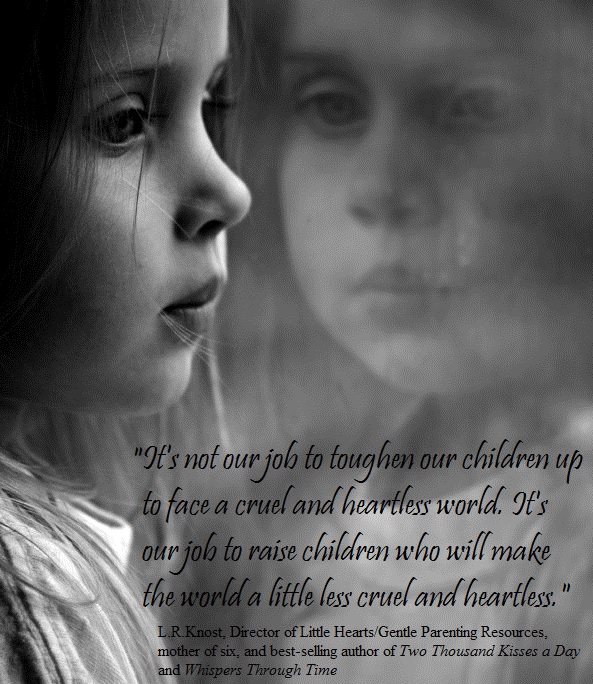 rates of youth violence and crime. Is it really the less than 10% of children who aren’t spanked who are responsible for all the problems of our society? Or could it be that the 90% of children who are subject to violence at home in the form of being slapped, paddled, smacked, yanked, whipped, popped, spanked, etc. are taking those lessons out into the world? Is it just possible that children who are hit learn to hit? That children who are hurt learn to hurt? Perhaps the lesson they are learning is that ‘might is right’ and violence is the answer to their problems, the outlet for their stress, the route to getting others to do what they want.
rates of youth violence and crime. Is it really the less than 10% of children who aren’t spanked who are responsible for all the problems of our society? Or could it be that the 90% of children who are subject to violence at home in the form of being slapped, paddled, smacked, yanked, whipped, popped, spanked, etc. are taking those lessons out into the world? Is it just possible that children who are hit learn to hit? That children who are hurt learn to hurt? Perhaps the lesson they are learning is that ‘might is right’ and violence is the answer to their problems, the outlet for their stress, the route to getting others to do what they want.
People throughout history have complained about ‘the trouble with kids today’ and they’ve pinned all the ills of their society on supposedly permissive parenting. They’ve ranted about out-of-control children, disrespectful youth, entitlement, spoiling, disobedience, violence, self-centeredness, etc:
“The children now love luxury. They have bad manners, contempt for authority, they show disrespect to their elders…. They no longer rise when elders enter the room. They contradict their parents, chatter before company, gobble up dainties at the table, cross their legs, and are tyrants over their teachers.” ~Socrates, 5th Century BC
“What is happening to our young people? They disrespect their elders, they disobey their parents. They ignore the law. They riot in the streets inflamed with wild notions. Their morals are decaying. What is to become of them?” ~Plato, 5th Century BC
“I see no hope for the future of our people if they are dependent on frivolous youth of today, for certainly all youth are reckless beyond words… When I was young, we were taught to be discreet and respectful of elders, but the present youth are exceedingly wise [disrespectful] and impatient of restraint” ~Hesiod, 8th Century BC
“The world is passing through troublous times. The young people of today think of nothing but themselves. They have no reverence for parents or old age. They are impatient of all restraint. They talk as if they knew everything, and what passes for wisdom with us is foolishness with them. As for the girls, they are forward, immodest and unladylike in speech, behavior and dress.” ~Peter the Hermit, 13th Century AD
Sounds familiar, doesn’t it? Maybe, though, there isn’t really any ‘trouble with kids today.’ Maybe the problem is with parents who repeat the patterns their own parents set or with societies who view normal stages of development as somehow abnormal.
Maybe ’kid’s today’ are just kids like they have been through the ages, full of exuberance and curiosity and learning their way in a great big world, and a listening ear, gentle guidance, and trusted arms to turn to when inevitable mistakes are made are really all children need to grow up into kind, helpful, responsible, productive members of our society.
The bottom line is that addressing our children’s underlying needs, the actual causes of their behavior instead of just the behavior itself, is a far more effective parental approach as well as being significantly better for a healthy, mutually respectful parent/child relationship. Sending our children out into the world as adults with their needs met, with coping mechanisms in place for those times when the stresses overwhelm them, and with the knowledge of a safe haven where comfort is always available when the world hurts them is a powerful way to change the world for the better.
Maybe, just maybe, sowing peace in our homes is the answer for our children, our families, and our world, after all.
*Also printed in The Natural Parent Magazine
Related posts:
Practical, Gentle, Effective Discipline
The Gift of a Strong-Willed Child
Backtalk is Communication…LISTEN
Bridge Over Troubled Waters~Parenting a ‘Problem’ Child
200 Ways to Bless Your Children with a Happy Childhood
12 Tips for Gently Parenting Your Adult Children (Hint: It starts when they’re newborns!)
The Measure of Success~Chinese Parents and French Parents Can’t BOTH Be Superior!
 Award-winnning author, L.R.Knost, is the founder and director of the children's rights advocacy and family consulting group, Little Hearts/Gentle Parenting Resources, and Editor-in-Chief of Holistic Parenting Magazine. Books by L.R.Knost include Whispers Through Time: Communication Through the Ages and Stages of Childhood ; Two Thousand Kisses a Day: Gentle Parenting Through the Ages and Stages ; The Gentle Parent: Positive, Practical, Effective Discipline ; and Jesus, the Gentle Parent: Gentle Christian Parenting the first four books in the Little Hearts Handbook gentle parenting series, and children’s picture books Petey’s Listening Ears and the soon-to-be-released Grumpykins series.
Award-winnning author, L.R.Knost, is the founder and director of the children's rights advocacy and family consulting group, Little Hearts/Gentle Parenting Resources, and Editor-in-Chief of Holistic Parenting Magazine. Books by L.R.Knost include Whispers Through Time: Communication Through the Ages and Stages of Childhood ; Two Thousand Kisses a Day: Gentle Parenting Through the Ages and Stages ; The Gentle Parent: Positive, Practical, Effective Discipline ; and Jesus, the Gentle Parent: Gentle Christian Parenting the first four books in the Little Hearts Handbook gentle parenting series, and children’s picture books Petey’s Listening Ears and the soon-to-be-released Grumpykins series.
Little Hearts Handbooks: Vote for Your Favorite Author Picture to Enter to Win a Pre-Release Copy!
![]() [Two Thousand Kisses a Day: Gentle Parenting Through the Ages and Stages by L.R.Knost now available. #14 on Amazon’s Top 100 New Releases in parenting!]
[Two Thousand Kisses a Day: Gentle Parenting Through the Ages and Stages by L.R.Knost now available. #14 on Amazon’s Top 100 New Releases in parenting!]
A winner has been chosen! For more opportunities to win a Little Hearts Handbook, follow Little Hearts/Gentle Parenting Resources by subscribing to receive updates from this website, on Face Book, Pinterest, and Twitter. Thank you to all who participated!
Exciting times ahead for Little Hearts! In the New Year, a series of handbooks based on the Little Hearts/Gentle Parenting Resources website will be released in paperback and for Kindle. The books will be approximately 120 pages and priced around $7.99 for paperback and $3.99 to $4.99 for Kindle. More details to come!
In celebration, we’re giving away a free, pre-release copy of the first handbook in the series, Two Thousand Kisses a Day~Gentle Parenting Through the Ages & Stages. Our official Little Hearts photographer from Melissa Lynsay Photography has outdone herself, and now we can’t decide on the best author picture for the back cover of the books.
We need your help deciding on a picture, so vote for your favorite author picture or comment on this post to register to win!
For voting purposes, we’ll call the picture above pic 1 and here is pic 2:
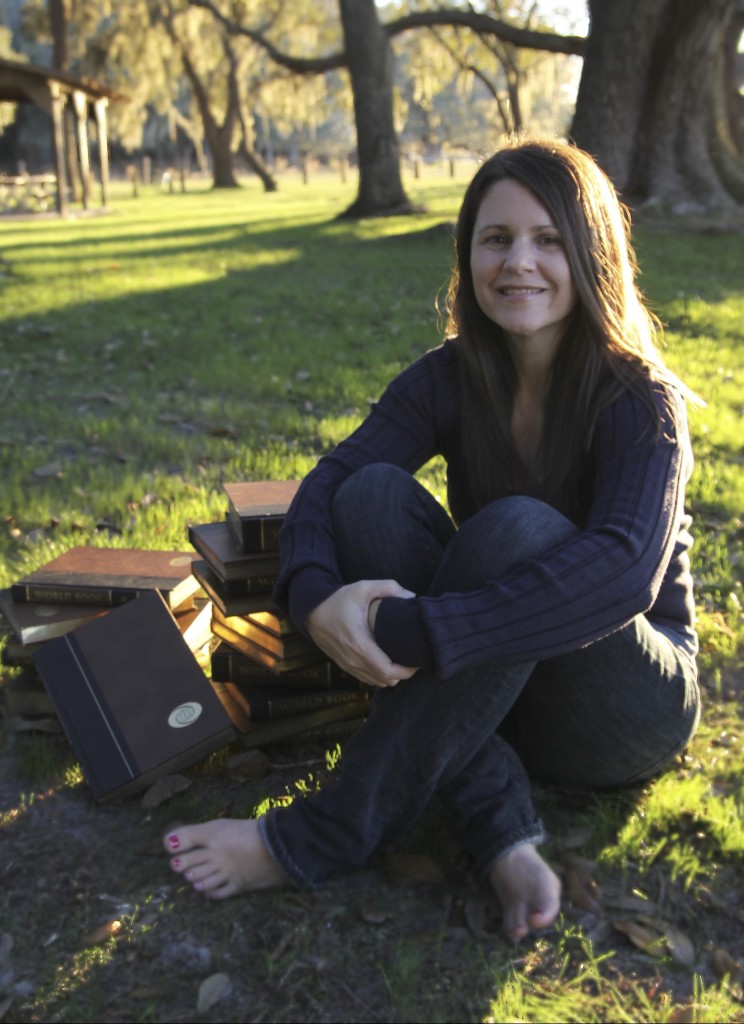
and pic 3:

Here are previews of the working copies of three of the book covers so you can see the pictures in ‘thumbnail’ form as they’ll be on the back cover. The actual handbooks are 6″ x 9″ so almost twice the size of these cover images which will make the pictures nearly double the size you see here:
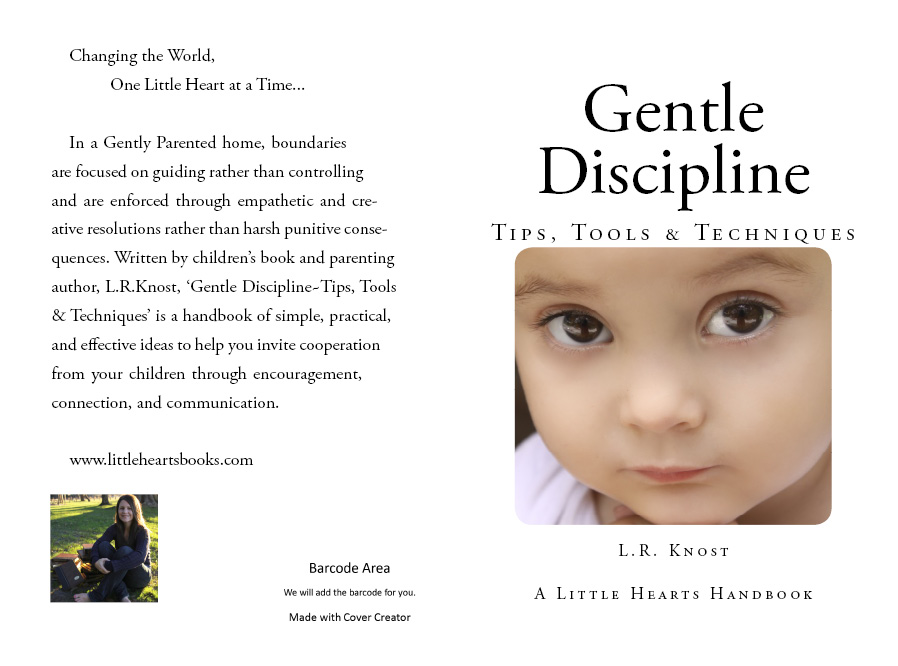
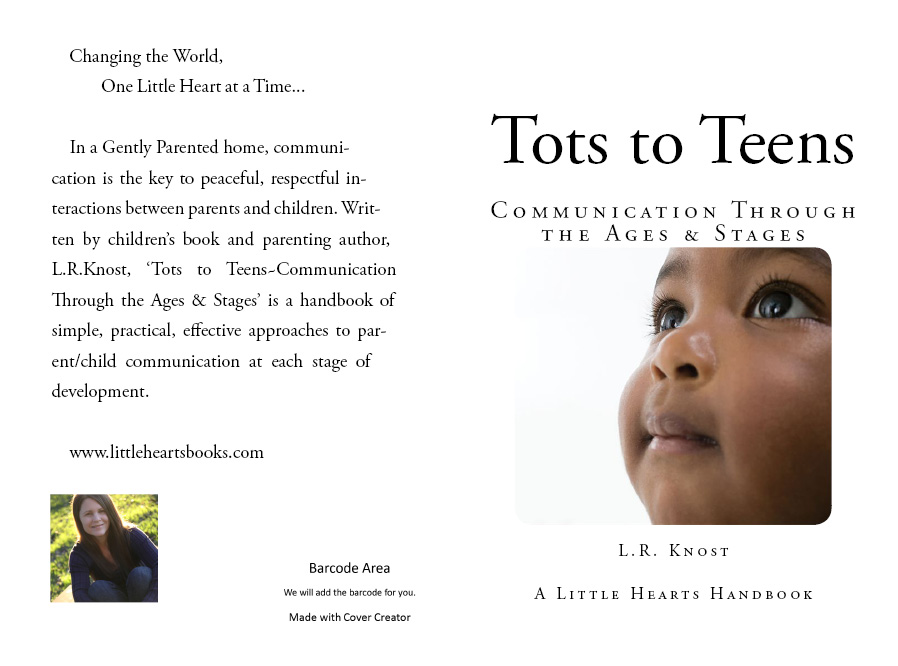
Okay, there you go! Vote for your favorite picture or leave a comment to register to win a free copy. It’s that easy!
 Award-winnning author, L.R.Knost, is the founder and director of the children's rights advocacy and family consulting group, Little Hearts/Gentle Parenting Resources, and Editor-in-Chief of Holistic Parenting Magazine. Books by L.R.Knost include Whispers Through Time: Communication Through the Ages and Stages of Childhood ; Two Thousand Kisses a Day: Gentle Parenting Through the Ages and Stages ; The Gentle Parent: Positive, Practical, Effective Discipline ; and Jesus, the Gentle Parent: Gentle Christian Parenting the first four books in the Little Hearts Handbook gentle parenting series, and children’s picture books Petey’s Listening Ears and the soon-to-be-released Grumpykins series.
Award-winnning author, L.R.Knost, is the founder and director of the children's rights advocacy and family consulting group, Little Hearts/Gentle Parenting Resources, and Editor-in-Chief of Holistic Parenting Magazine. Books by L.R.Knost include Whispers Through Time: Communication Through the Ages and Stages of Childhood ; Two Thousand Kisses a Day: Gentle Parenting Through the Ages and Stages ; The Gentle Parent: Positive, Practical, Effective Discipline ; and Jesus, the Gentle Parent: Gentle Christian Parenting the first four books in the Little Hearts Handbook gentle parenting series, and children’s picture books Petey’s Listening Ears and the soon-to-be-released Grumpykins series.
When Children Hit~10 Tips for Parents
[Portions reprinted from The Gentle Parent: Positive, Practical, Effective Discipline by L.R.Knost. Two Thousand Kisses a Day: Gentle Parenting Through the Ages and Stages and Whispers Through Time: Communication Through the Ages and Stages of Childhood also available on Amazon and through other major retailers.]
 Toddlers and preschoolers are still in the early stages of learning to communicate verbally. Add to that the fact that they have little-to-no impulse control and very immature social skills, and you’ve got a recipe for an instinctive physical response (i.e. hitting, kicking, biting, hair pulling, throwing things, etc.) to situations in which they are frustrated, angry, scared, or just tired and out-of-sorts.
Toddlers and preschoolers are still in the early stages of learning to communicate verbally. Add to that the fact that they have little-to-no impulse control and very immature social skills, and you’ve got a recipe for an instinctive physical response (i.e. hitting, kicking, biting, hair pulling, throwing things, etc.) to situations in which they are frustrated, angry, scared, or just tired and out-of-sorts.
Many parents who practice gentle discipline wonder where their little one picked up the behavior, not realizing that it is a normal and age-appropriate reaction, albeit an unacceptable one. Very often parents are advised to spank their child to train them not to hit others, especially those who are smaller and weaker than they are. (more…)
 Award-winnning author, L.R.Knost, is the founder and director of the children's rights advocacy and family consulting group, Little Hearts/Gentle Parenting Resources, and Editor-in-Chief of Holistic Parenting Magazine. Books by L.R.Knost include Whispers Through Time: Communication Through the Ages and Stages of Childhood ; Two Thousand Kisses a Day: Gentle Parenting Through the Ages and Stages ; The Gentle Parent: Positive, Practical, Effective Discipline ; and Jesus, the Gentle Parent: Gentle Christian Parenting the first four books in the Little Hearts Handbook gentle parenting series, and children’s picture books Petey’s Listening Ears and the soon-to-be-released Grumpykins series.
Award-winnning author, L.R.Knost, is the founder and director of the children's rights advocacy and family consulting group, Little Hearts/Gentle Parenting Resources, and Editor-in-Chief of Holistic Parenting Magazine. Books by L.R.Knost include Whispers Through Time: Communication Through the Ages and Stages of Childhood ; Two Thousand Kisses a Day: Gentle Parenting Through the Ages and Stages ; The Gentle Parent: Positive, Practical, Effective Discipline ; and Jesus, the Gentle Parent: Gentle Christian Parenting the first four books in the Little Hearts Handbook gentle parenting series, and children’s picture books Petey’s Listening Ears and the soon-to-be-released Grumpykins series.
You’re Not the Boss of Me!
 [Portions reprinted from The Gentle Parent: Positive, Practical, Effective Discipline by L.R.Knost. Two Thousand Kisses a Day: Gentle Parenting Through the Ages and Stages and Whispers Through Time: Communication Through the Ages and Stages of Childhood also available on Amazon and through other major retailers.]
[Portions reprinted from The Gentle Parent: Positive, Practical, Effective Discipline by L.R.Knost. Two Thousand Kisses a Day: Gentle Parenting Through the Ages and Stages and Whispers Through Time: Communication Through the Ages and Stages of Childhood also available on Amazon and through other major retailers.]
Few things ignite a parent’s temper like defiance. It feels like a slap in the face, a direct challenge to our authority. Power card…played. Gauntlet…thrown. Challenge…accepted?
Time out! No, not time-out as in punish your child, but time out as in hit the parental pause button, take a step back, assess the situation, and get some adult perspective.
There are three things to consider:
- Behaviors are communication. What is your child trying to communicate?
- Is the behavior really defiance, or did your child’s action hit a nerve in you for some reason?
- If the behavior is, in fact, defiance, what circumstances preceded it?
Once you’ve assessed the situation, you can more effectively address it. If your child is communicating an unmet need such as a need for more interaction from you, a need to be heard, or if they simply need an outlet for their energy, you can first meet those needs and then offer your child ideas about how to better communicate their needs to you in the future.
The same process applies if your child’s behavior is communicating stress, anger, fear, or insecurity. Taking a step back allows you to not only see the emotion behind the action, but also gives you a moment to consider if there have been any big transitions in your child’s life such as a move or change in childcare or a recent illness (or, possibly, a breach in trust if you have ‘lost it’ and yelled, threatened, or spanked) that they may have big feelings about but are not able to articulate. First you can meet those emotional needs with empathic listening, offering words to help them articulate their feelings, apologizing if you have broken trust with them, and providing an outlet for their pent up emotions. Then you can address their behavior by giving them options for expressing their needs in more acceptable ways.
Meeting their needs before addressing their behavior is vital because it lowers their defenses, clears whatever is cluttering up your parent/child connection, and opens the pathways to communication, in effect turning on their listening ears!
*On a side note, be aware that it is possible, especially with very young children, that what you are interpreting as defiance is actually age-appropriate curiosity and exploration. A twelve month old who repeatedly pulls the cat’s tail may be experimenting with the interesting sound the cat makes, the soft texture of the fur, her own feeling of power, or just trying to find out if pulling the tail is as ‘not-okay’ after her nap as it was before. Little ones too young to grasp the concept of permanence (typically those less than twenty-four to thirty months) live very much in the moment and cannot be expected to understand the permanent nature of rules and limits. Removing temptations (commonly referred to as baby-proofing) is not only for their safety, but is also a visual form of limit setting. A common misconception is that removing temptations is passive or indulgent parenting, but it is actually proactive parenting (whereas passive/indulgent parenting would be simply allowing the behavior) and is an effective and gentle beginning to the process of boundary setting.
If in taking a step back to assess the situation you discover that your child’s behavior isn’t really defiance, but a nerve was hit in you that caused you to perceive it that way, you can first address your child’s need and then their behavior, if necessary, but then take the time to address your own needs. Perhaps you have an unmet need to be heard by your spouse, boss, or even your own parents, or maybe there is a wound from your past that needs to be healed or a source of stress in your life that is causing you to feel overwhelmed. Taking an honest look at your own needs and hurts and stressors and dealing with those issues will not only benefit your parenting, but your life in general!
If your ‘time out’ assessment reveals that the circumstances preceding your child’s defiance contributed to it, you can learn from that and find ways to avoid those circumstances in the future. For instance, you may realize that hunger or tiredness or over-scheduling are triggers for your child’s behavior. Or you may see that your wording is provoking a negative response. (The word ‘no’ can be a trigger for a power struggle. Try rephrasing your no’s into yes’s. For instance, instead of “No, you can’t have ice cream until after dinner” you could try “I know you love ice cream. I do, too! We’re getting ready to eat right now, but what flavor would you like after dinner?” The objective is to set the same limit, but phrase it in a way that invites cooperation instead of triggering opposition.) You might realize you are inadvertently communicating your own stress to your child or even taking it out on them. Or you may have slipped into a negative parenting pattern and be ‘powering up’ on your child, in effect throwing down the gauntlet yourself, and they are merely reflecting your behavior. Whatever the case may be, learn from it, make the necessary adjustments, repair your relationship with an apology if needed, reconnect with your child, and then share ideas about better ways both of you can handle things in the future.
Keep in mind, though, that sometimes what parents perceive as defiance is really just a child testing their boundaries to make sure that they are secure. Children need to know they’re safe, and a parent who is confident and comfortable enough in their leadership to calmly and gently guide their child to stay within their boundaries is very reassuring. The goal of gentle parenting, however, is not controlling children, but equipping them to control themselves (in other words, we want to teach them to be ‘the boss’ of themselves!) So if your child is testing their boundaries, be careful to respond with guidance, not punishment.
Finally, remember, you are raising a little human with thoughts, needs, ideas, and a personality all their own. They aren’t perfect any more than you are, and expecting perfection will lead to conflict, not connection. When they make mistakes, choose understanding, not anger. When they make poor choices, choose guidance, not punishment. And when they challenge your authority and throw down that gauntlet of defiance, choose peace, not warfare. Remember, you don’t have to attend every fight you’re invited to!
~~~~~~~~~~~~~~
Related posts:
Toddlers, Tantrums, and Time-In’s, Oh My!
The Gift of a Strong-Willed Child
Backtalk is Communication…LISTEN
When Children Act Out ~ Reflecting Our Emotions
Bridge Over Troubled Waters~Parenting a ‘Problem’ Child
The Taming of the Tantrum: A Toddler’s Perspective
Practical, Gentle, Effective Discipline
200 Ways to Bless Your Children with a Happy Childhood
 Award-winnning author, L.R.Knost, is the founder and director of the children's rights advocacy and family consulting group, Little Hearts/Gentle Parenting Resources, and Editor-in-Chief of Holistic Parenting Magazine. Books by L.R.Knost include Whispers Through Time: Communication Through the Ages and Stages of Childhood ; Two Thousand Kisses a Day: Gentle Parenting Through the Ages and Stages ; The Gentle Parent: Positive, Practical, Effective Discipline ; and Jesus, the Gentle Parent: Gentle Christian Parenting the first four books in the Little Hearts Handbook gentle parenting series, and children’s picture books Petey’s Listening Ears and the soon-to-be-released Grumpykins series.
Award-winnning author, L.R.Knost, is the founder and director of the children's rights advocacy and family consulting group, Little Hearts/Gentle Parenting Resources, and Editor-in-Chief of Holistic Parenting Magazine. Books by L.R.Knost include Whispers Through Time: Communication Through the Ages and Stages of Childhood ; Two Thousand Kisses a Day: Gentle Parenting Through the Ages and Stages ; The Gentle Parent: Positive, Practical, Effective Discipline ; and Jesus, the Gentle Parent: Gentle Christian Parenting the first four books in the Little Hearts Handbook gentle parenting series, and children’s picture books Petey’s Listening Ears and the soon-to-be-released Grumpykins series.
The Trouble With Kids Today
[Portions reprinted from Two Thousand Kisses a Day: Gentle Parenting Through the Ages and Stages by L.R.Knost available on Amazon]
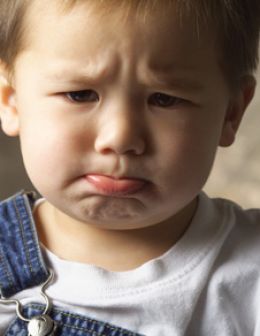 “People are telling parents like me that we are failing our children because we practice controlled discipline in our homes. I say: the children that are raised without it are the ones being abused and robbed of the chance of success in adulthood.” Controlled discipline in the eyes of this author of I Don’t Like Spanking My Kids, But I Do It Anyway is physical punishment. Equating discipline with punishment is a common misconception, but she is, unfortunately, not alone in her stance.
“People are telling parents like me that we are failing our children because we practice controlled discipline in our homes. I say: the children that are raised without it are the ones being abused and robbed of the chance of success in adulthood.” Controlled discipline in the eyes of this author of I Don’t Like Spanking My Kids, But I Do It Anyway is physical punishment. Equating discipline with punishment is a common misconception, but she is, unfortunately, not alone in her stance.
Many of today’s most popular self-proclaimed parenting ‘experts’ also equate physical punishment with discipline and go to great lengths to describe the best methods and tools for hitting children along with instructing parents to maintain a calm, controlled, and even cheerful demeanor as they ‘lovingly’ hit their children.
It is interesting to note here that, when it comes to the law, crimes of passion are treated as less heinous than premeditated, planned, and purposefully executed crimes which are termed ‘in cold blood.’ And yet when physically punishing a child, a crime in many places across the globe, hitting in anger or frustration (i.e. passion) is deemed wrong by proponents of spanking, while hitting children with calm and deliberate intent (i.e. premeditation) is encouraged.
It is also interesting to note that, in the not-too-distant past, husbands hitting their wives was also viewed as not only a societal norm, but a necessary part of maintaining a harmonious, successful marriage. In fact, a man who epitomizes the words calm and controlled, Sean Connery, shared his thoughts on the ‘reasonable smacking’ of his wife in a 1987 interview with Barbara Walters:
The core belief behind ‘reasonable smacking’ of wives was that there was no other effective way to control them. I have to agree. If controlling another human being is the goal, then force is necessary. Fear, intimidation, threats, power-plays, physical pain, those are the means of control.
But if growing healthy humans is the goal, then building trust relationships, encouraging, guiding, leading, teaching, communicating, those are the tools for success.
Many parents simply don’t know what else to do. They were raised with spanking as a means of control and “turned out okay” so they default to their own parents’ parenting choices without researching alternatives to spanking or considering whether “okay” could be improved upon.
As to the I Don’t Like Spanking My Kids, But I Do It Anyway author’s contention that “We are raising a generation of children who are over-sensitive because they eventually find out that they aren’t as good at baseball or ballet as some other kid and their parents promised them that everyone is equal. They feel entitled because we teach them that they should. They throw tantrums when life doesn’t go their way because their parents have tiptoed around them to make sure that it does,” that reasoning sounds strangely familiar.
People throughout history have complained about ‘the trouble with kids these days.’ They’ve pinned all the ills of their society on permissive parenting. They’ve ranted about out-of-control children, disrespectful youth, entitlement, spoiling, disobedience, violence, self-centeredness, etc:
“The children now love luxury. They have bad manners, contempt for authority, they show disrespect to their elders…. They no longer rise when elders enter the room. They contradict their parents, chatter before company, gobble up dainties at the table, cross their legs, and are tyrants over their teachers.”
~Socrates, 5th Century BC“What is happening to our young people? They disrespect their elders, they disobey their parents. They ignore the law. They riot in the streets inflamed with wild notions.
Their morals are decaying. What is to become of them?”
~Plato, 5th Century BC“I see no hope for the future of our people if they are dependent on frivolous youth of today, for certainly all youth are reckless beyond words… When I was young, we were taught to be discreet and
respectful of elders, but the present youth are exceedingly wise [disrespectful] and impatient of restraint”
~Hesiod, 8th Century BC“The world is passing through troublous times. The young people of today think of nothing but themselves. They have no reverence for parents or old age. They are impatient of all restraint. They talk as if they knew everything, and what passes for wisdom with us is foolishness with them. As for the girls, they are forward, immodest and unladylike in speech, behavior and dress.”
~Peter the Hermit, 13th Century ADMy grandpa notes the world’s worn cogs
And says we’re going to the dogs.
His grandpa in his house of logs
Said things were going to the dogs.
His grandpa in the Flemish bogs
Said things were going to the dogs.
His grandpa in his hairy togs
Said things were going to the dogs.
But this is what I wish to state:
The dogs have had an awful wait.
~Unknown, circa 1936Small children disturb your sleep, big children your life.
~Yiddish Proverb
Perhaps, just perhaps, there isn’t any ‘trouble with kids today.’ Maybe the trouble is with societies who view normal stages of development as somehow abnormal. Maybe the problem is with parents who repeat the patterns their own parents set and don’t delve into the belief system they are now passing along to their children. Or maybe the problem is simply the rose-colored glasses older generations tend to have about their own youth when they share idealized versions of ‘the good old days.’
Could it be that ‘kid’s today’ are just kids like they have been through the ages, full of exuberance and curiosity and learning their way in a great big world? Could it be that a listening ear, gentle guidance, and trusted arms to turn to when inevitable mistakes are made are really all children need to grow up into kind, helpful, responsible, productive members of our society?
Consider this, “Since more than 90% of American parents admit to spanking their children, it’s hard to accept that a decline in spanking is responsible for the purportedly escalating rates of youth violence and crime. Could it be that the 90% of children who are subject to violence at home in the form of being slapped, paddled, smacked, yanked, whipped, popped, spanked, etc. are taking those lessons out into the world? Is it just possible that children who are hit learn to hit? That children who are hurt learn to hurt? Perhaps the lesson they are learning is that ‘might is right’ and violence is the answer to their problems, the outlet for their stress, the route to getting others to do what they want.” Better Children, Better World
Could it be that sowing peace in our homes is the answer after all?
Related posts:
Practical, Gentle, Effective Discipline
Spare the Rod: The Heart of the Matter
Tots to Teens~Communication Through the Ages and Stages
Testing the Boundaries~What’s A Parent To Do?
One Slippery Sock & Other Silly Tools for your Parenting Toolbox!
The Measure of Success~Chinese Parents and French Parents Can’t BOTH Be Superior!
 Award-winnning author, L.R.Knost, is the founder and director of the children's rights advocacy and family consulting group, Little Hearts/Gentle Parenting Resources, and Editor-in-Chief of Holistic Parenting Magazine. Books by L.R.Knost include Whispers Through Time: Communication Through the Ages and Stages of Childhood ; Two Thousand Kisses a Day: Gentle Parenting Through the Ages and Stages ; The Gentle Parent: Positive, Practical, Effective Discipline ; and Jesus, the Gentle Parent: Gentle Christian Parenting the first four books in the Little Hearts Handbook gentle parenting series, and children’s picture books Petey’s Listening Ears and the soon-to-be-released Grumpykins series.
Award-winnning author, L.R.Knost, is the founder and director of the children's rights advocacy and family consulting group, Little Hearts/Gentle Parenting Resources, and Editor-in-Chief of Holistic Parenting Magazine. Books by L.R.Knost include Whispers Through Time: Communication Through the Ages and Stages of Childhood ; Two Thousand Kisses a Day: Gentle Parenting Through the Ages and Stages ; The Gentle Parent: Positive, Practical, Effective Discipline ; and Jesus, the Gentle Parent: Gentle Christian Parenting the first four books in the Little Hearts Handbook gentle parenting series, and children’s picture books Petey’s Listening Ears and the soon-to-be-released Grumpykins series.
The Age of Fear: 8 Tips to Help Young Children Cope with Anxiety
[Reprinted from Two Thousand Kisses a Day: Gentle Parenting Through the Ages and Stages by L.R.Knost. Whispers Through Time: Communication Through the Ages and Stages of Childhood and The Gentle Parent: Positive, Practical, Effective Discipline also now available on Amazon and through other major retailers.]
Your once fearless five-year-old suddenly refuses to leave your side at the park saying, “I’m afraid the birds will eat me,” while eyeing the tiny swallows hopping on the ground as if they’re evil geniuses plotting his demise.
Your three-year-old, whom you once found proudly grinning while sitting atop the refrigerator, has abruptly decided the swings are objects of abject terror that will, “Fly me to the ground.” (Translation: I’ll fall off!)
Your six-year-old who has slept like a log in his own bed for years is suddenly resisting bedtime and climbing into your bed with you at 3 am every. single. night.
Your happy little four-year-old suddenly becomes withdrawn and clingy, refusing to play with her playdate friends and wanting to sit in your lap. And, even worse, she’s started sucking her thumb again!
The preschool and early elementary school years are sometimes marred with exaggerated fears, odd anxieties, nightmares, night terrors, and other evidences of insecurity that can make the most confident of parents feel a combination of dismay, frustration, worry, and failure. Regression is a common accompaniment, from pottying accidents to night-waking to thumb-sucking. Often, acting-out behaviors also increase in this time period.
So, what in the world is going on?
No, it’s not an environmental-toxin-induced, super-early-onset of adolescent-hormone-overload. And, normally, it’s not a trauma-reaction to life changes such as moving or starting preschool or school, though those events can exacerbate the issue. (Be aware that these behaviors can, rarely, indicate an anxiety disorder, stress-overload, or abuse. If you suspect any of these things may be causing your child’s behavior, seek a professional evaluation.)
Typically, though, sudden anxiety behaviors in preschool/early elementary aged children are simply another normal stage of development, an indication of cognitive growth. In other words, as odd as it sounds, fear can be a sign of maturity!
Children in the three to six-year-old age range (Keep in mind that this is a rough age estimate. Children are individuals, not pre-programmed robots!) are beginning to realize that their parents aren’t the all-powerful beings that they once believed them to be. This realization can be very uncomfortable for them, causing them a great deal of unease as they are concurrently beginning to realize that there is a whole, big, wide world beyond their safe, little home, and that that world is full of potential dangers, hazards unknown, and just a lot of really big, scary things.
So what is a parent to do with their newly timid little house-mouse?
First, be aware that there is no one-size-fits-all miracle ‘cure.’ You know your child better than anyone else, and being responsive to her unique needs means taking your cues from her as to what may help or hinder her journey through this uncomfortable stage.
That said, here are some ideas that may help:
- Before forcing your child to ‘face his fears,’ consider whether someone throwing a spider on you if you are deathly afraid of spiders or locking you in a closet if you’re claustrophobic would be helpful to you in overcoming your fears. If the answer is ‘NO!’ then honor your child’s feelings and move on to another solution.
- When your child voices her concerns, resist the urge to minimize them. If she says, “I’m afraid of monsters coming in my window,” try not to say, “There’s no such thing as monsters.” Remember, she’s realizing you aren’t all-powerful, and that means you aren’t all-knowing, either! Rather than be reassured by your words, she’ll simply think you don’t know about the monsters and can’t help her and keep her safe. Instead, you can brainstorm ideas together to keep the monsters at bay. While you don’t want to say that monsters actually do exist, you can say something like, “Let’s think of ways to keep you safe. What if daddy throws the monsters away in the trashcans outside and the trashman takes them away?” Don’t be afraid to be seriously silly. In other words, take her fears seriously, but offer silly solutions that offer visuals of the monsters (or whatever the fear is) going away forever.
- Help your child to make a ‘nightmare safe’ out of a shoe box. At night
 before he goes to bed, sit with him and encourage him to put all his scary thoughts in the box for you to take and keep safely away from him while he sleeps. Let him know that if he does have a bad dream, he can come to you even if it’s the middle of the night, and you’ll help him to put the scary dream in the box so he’ll be able to go back to sleep.
before he goes to bed, sit with him and encourage him to put all his scary thoughts in the box for you to take and keep safely away from him while he sleeps. Let him know that if he does have a bad dream, he can come to you even if it’s the middle of the night, and you’ll help him to put the scary dream in the box so he’ll be able to go back to sleep.
- Avoid phrases such as “You’re a big boy now” and “Only babies do that.” Focus instead on encouraging your child to do the things you know he can do. For instance, if he’s usually able to climb the ladder on the slide but gets ‘stuck’ halfway up and asks for help, start by moving near so he knows you are close and willing to help him if needed. Then verbally encourage him, “I know you can do it. I’m here if you need me.” But don’t pressure him. If he gets upset or insists he can’t do it, help him down. Remember, it isn’t really about the slide at all. It’s about seeking reassurance that you can still be trusted to take care of him, that he’s still safe with you.
-
 If the occasional monster in the closet or under the bed needs to be evicted, try reading a book like Go Away, Big Green Monster! and make your own ‘Monster-Away Spray,’ to send all the scary monsters packing. The ones we made didn’t match the colors in the book perfectly because we just used foam stickers and googlie eyes from our craft box and blue spray bottles from the bargain bin at the fabric store, but my girls were thrilled with them. We filled them with water (and added a little spritz of febreeze in my six-year-old’s bottle because, “Monsters can’t STAND flowers!”) and then Daddy and Big Brother took turns pretending to be monsters and ran away squealing from the girls when they got sprayed. Role-playing with children (and just playing with them, period!) is a powerful tool in helping them learn coping skills. Now, a bit of bedtime spritzing in closets and under beds is all it takes to make my girls feel confident that they’ve rousted the beasties so they can sleep in peace!
If the occasional monster in the closet or under the bed needs to be evicted, try reading a book like Go Away, Big Green Monster! and make your own ‘Monster-Away Spray,’ to send all the scary monsters packing. The ones we made didn’t match the colors in the book perfectly because we just used foam stickers and googlie eyes from our craft box and blue spray bottles from the bargain bin at the fabric store, but my girls were thrilled with them. We filled them with water (and added a little spritz of febreeze in my six-year-old’s bottle because, “Monsters can’t STAND flowers!”) and then Daddy and Big Brother took turns pretending to be monsters and ran away squealing from the girls when they got sprayed. Role-playing with children (and just playing with them, period!) is a powerful tool in helping them learn coping skills. Now, a bit of bedtime spritzing in closets and under beds is all it takes to make my girls feel confident that they’ve rousted the beasties so they can sleep in peace!
- If regression is an issue, keep in mind that your child is self-comforting by returning to a time she felt safe. Rather than punishing, ridiculing, bribing, or in other ways trying to ‘control’ the behavior, offer comfort in appropriate ways to demonstrate that she can trust you to meet her comfort/safety needs. This applies to acting-out behaviors, as well. Set boundaries, certainly, and provide plenty of guidance, but remember that punishment tends to push children farther away rather than connecting with them. Since your child is reacting to a feeling of disconnection from you in her new understanding of your non-superhero status, pushing her further away will merely exacerbate the issue, not solve it.
- Just listen. This is the simplest solution to a rather complex problem. Slow down and make time to just take a walk with your child. Sit with him in the evening and watch him color or play a quiet board game with him. Lay with him in his bed for a few minutes before he sleeps and chat about the day. Just the fact of you taking the time to focus on him, to be quiet with him, to enjoy his company, and to reconnect with him will go a long way towards soothing his fears.
- Even if your child isn’t introverted by nature, the following table offers some wonderful tips that translate well into this brief anxiety stage:
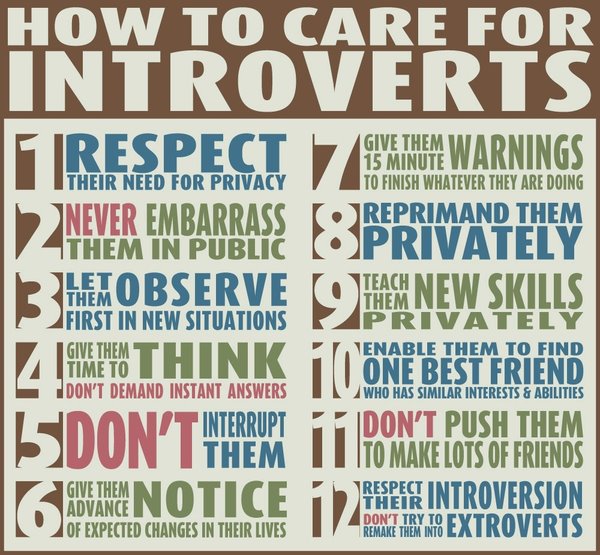
Remember, just like all the other stages of development, this ‘age of fear’ won’t last forever. Staying connected with your child and keeping the communication lines open through the ages and stages of development will help to ease their way as well as keeping your relationship strong and healthy.
Related posts:
Toddlers, Tantrums, and Time-Ins, Oh My!
Testing the Boundaries~What’s A Parent To Do?
To a Toddler Sharing is a 4 Letter Word~MINE!
Babes and Boundaries~A Gentle Parenting Perspective
Your Baby isn’t Trying to Annoy You; He’s Trying to Communicate!
 Award-winnning author, L.R.Knost, is the founder and director of the children's rights advocacy and family consulting group, Little Hearts/Gentle Parenting Resources, and Editor-in-Chief of Holistic Parenting Magazine. Books by L.R.Knost include Whispers Through Time: Communication Through the Ages and Stages of Childhood ; Two Thousand Kisses a Day: Gentle Parenting Through the Ages and Stages ; The Gentle Parent: Positive, Practical, Effective Discipline ; and Jesus, the Gentle Parent: Gentle Christian Parenting the first four books in the Little Hearts Handbook gentle parenting series, and children’s picture books Petey’s Listening Ears and the soon-to-be-released Grumpykins series.
Award-winnning author, L.R.Knost, is the founder and director of the children's rights advocacy and family consulting group, Little Hearts/Gentle Parenting Resources, and Editor-in-Chief of Holistic Parenting Magazine. Books by L.R.Knost include Whispers Through Time: Communication Through the Ages and Stages of Childhood ; Two Thousand Kisses a Day: Gentle Parenting Through the Ages and Stages ; The Gentle Parent: Positive, Practical, Effective Discipline ; and Jesus, the Gentle Parent: Gentle Christian Parenting the first four books in the Little Hearts Handbook gentle parenting series, and children’s picture books Petey’s Listening Ears and the soon-to-be-released Grumpykins series.
To a Toddler Sharing is a 4 Letter Word~MINE!
[Reprinted from Two Thousand Kisses a Day: Gentle Parenting Through the Ages and Stages by L.R.Knost. Whispers Through Time: Communication Through the Ages and Stages of Childhood and The Gentle Parent: Positive, Practical, Effective Discipline also now available on Amazon and through other major retailers.]
 Almost from the moment a baby is born, parents teach them not to share. “No, no, sweetie. That’s mommy’s” and “That’s daddy’s, not yours” accompanied by the removal of whatever the forbidden item is are daily realities for little ones. This is unavoidable, of course, since bacteria-ridden keys don’t belong in little mouths and iphones don’t work well when soaked in drool.
Almost from the moment a baby is born, parents teach them not to share. “No, no, sweetie. That’s mommy’s” and “That’s daddy’s, not yours” accompanied by the removal of whatever the forbidden item is are daily realities for little ones. This is unavoidable, of course, since bacteria-ridden keys don’t belong in little mouths and iphones don’t work well when soaked in drool.
But the challenge comes when our little ‘reflectors’ are expected to share their toys with anyone and everyone who takes a liking to them. (Keep in mind that “their toys” as defined by a toddler are anything they own, are playing with, want to play with, don’t want to play with but want to remain available, etc.) It’s fully acceptable for us adults to not share our ‘toys’ with others, though. How often do we invite friends over and hand them the keys to our car? And yet we get to choose our own friends, do the inviting, and we have adult reasoning skills and judgment in place…things small children don’t have control over or access to!
The primary learning mode for little ones is imitation, but still we expect them to somehow have the cognitive maturity to learn to share despite their parents not sharing their ‘toys’ with them and despite seeing their parents not sharing their ‘toys’ with their own friends.
On top of that, we’re expecting them to grasp some pretty intricate and tricky relational nuances. What does ‘being a good friend’ entail? Why is someone taking something I want an acceptable part of friendship? If they can take what I want, why can’t I take what they want?
And, to round off the difficulty, ownership is an advanced, abstract concept and sharing is even more so. The difference between sharing and giving away forever or between someone borrowing your things and someone stealing from you is rather nebulous in the mind of a child. Now add in a complete inability to grasp time concepts (They get my toy for a minute? How long is a minute? When mommy tells me ‘just a minute’ when she’s on the phone it seems like forever before she’s done!) and to understand other abstract concepts such as permanence, and you can see the murky waters tiny people are expected to navigate when it comes to understanding sharing!
Obviously, little ones need help overcoming all of these obstacles. Punishing them, calling them selfish brats, forcing them to share, etc. are all counterproductive, not to mention damaging to the very relationship that is pivotal to eventual understanding of the concept of sharing. Going back to that primary learning mode of imitation, the key to teaching a child to share lies in the trust relationship being built by gentle, responsive parenting:
1.) When a child is secure in their relationship with their parents, when they know they will be heard, when they trust that their needs will be met quickly and consistently, much of the impetus behind the refusal to share is removed simply because the child isn’t living in a constant state of ‘fight or flight’ response. (This is not to say they will share freely, no matter how gentle the parenting. The afore mentioned obstacles are still in play, and your little ones are still human. What it does mean is that some of the impediments to sharing are removed and the stage is set for learning.)
2.) Within the context of the parent/child relationship, be mindful of how often you say ‘no’ or ‘mine’ and try to offer alternatives in the moment to model sharing.
3.) Be aware of the fact that your child isn’t choosing their own friends at this point and neither they nor their little playmates are skilled socially yet. Stay nearby and in tune with your little one so you can step in and help them deal with any sharing difficulties such as snatching or tug-o-war with a toy before they escalate.
4.) Use concrete words to guide your little one in social situations. For example, try “Use your gentle hands” instead of “Don’t snatch/hit/push.”
5.) Resist the embarrassed-adult-knee-jerk-reaction of scolding your child, snatching toys from them to give to another child, and punishing your child for a normal developmental stage. That kind of reaction not only doesn’t model self-control, but it also doesn’t model acceptable social behavior, which is exactly what you’re upset about your child not displaying!
6.) Prepare for playdates by putting away any treasured toys such as special lovies or new toys that you know your little one will have trouble sharing. Honoring their feelings about these few special things will help them to feel more comfortable sharing their other toys because you are showing them in a concrete manner that you will help them to protect and preserve the things that matter to them.
7.) Play sharing games with your child daily to practice this advanced skill. When she says “Mine!” respond by smiling, picking up something of yours you don’t mind her playing with, and saying, “This is mine. I’ll share!” and hand it to her. Often little ones will start running around picking up their toys and bringing them to you to ‘share’ and wait for it to be reciprocated, resulting in a back and forth, back and forth sharing game that taps into another excellent learning mode for children…play!
Above all, keep in mind that sharing is a learned skill and it will take time for your  small one to grow into a socially skilled little butterfly. Creating an atmosphere of trust, modeling sharing, and honoring their feelings will surround them with a safe environment in which they can develop the skills needed to become the most treasured of friends!
small one to grow into a socially skilled little butterfly. Creating an atmosphere of trust, modeling sharing, and honoring their feelings will surround them with a safe environment in which they can develop the skills needed to become the most treasured of friends!
Related posts:
Toddlers, Tantrums, and Time-Ins, Oh My!
Testing the Boundaries~What’s A Parent To Do?
Babes and Boundaries~A Gentle Parenting Perspective
Your Baby isn’t Trying to Annoy You; He’s Trying to Communicate!
 Award-winnning author, L.R.Knost, is the founder and director of the children's rights advocacy and family consulting group, Little Hearts/Gentle Parenting Resources, and Editor-in-Chief of Holistic Parenting Magazine. Books by L.R.Knost include Whispers Through Time: Communication Through the Ages and Stages of Childhood ; Two Thousand Kisses a Day: Gentle Parenting Through the Ages and Stages ; The Gentle Parent: Positive, Practical, Effective Discipline ; and Jesus, the Gentle Parent: Gentle Christian Parenting the first four books in the Little Hearts Handbook gentle parenting series, and children’s picture books Petey’s Listening Ears and the soon-to-be-released Grumpykins series.
Award-winnning author, L.R.Knost, is the founder and director of the children's rights advocacy and family consulting group, Little Hearts/Gentle Parenting Resources, and Editor-in-Chief of Holistic Parenting Magazine. Books by L.R.Knost include Whispers Through Time: Communication Through the Ages and Stages of Childhood ; Two Thousand Kisses a Day: Gentle Parenting Through the Ages and Stages ; The Gentle Parent: Positive, Practical, Effective Discipline ; and Jesus, the Gentle Parent: Gentle Christian Parenting the first four books in the Little Hearts Handbook gentle parenting series, and children’s picture books Petey’s Listening Ears and the soon-to-be-released Grumpykins series.
Avenging Childhood~The Change Makers
As I drove out of my driveway this afternoon, I glanced up and saw The Avengers racing around my neighbor’s yard, intent on fighting crime (or each other or the dog or some dragonflies, lol). It made my heart so happy to see childhood…just real, everyday, the-way-children-through-the-ages-have-played kind of childhood at its most honest and robust and carefree. I jumped out of my van and proceeded to confirm my neighbor’s suspicions that I’m a little off my rocker by wildly waving my camera in the air and pointing at her adorable boys roughhousing, silently asking for permission to play paparazzi. She nodded, and the boys hammed it up for me for a few minutes, posing and posturing in their wonderful world of make-believe.
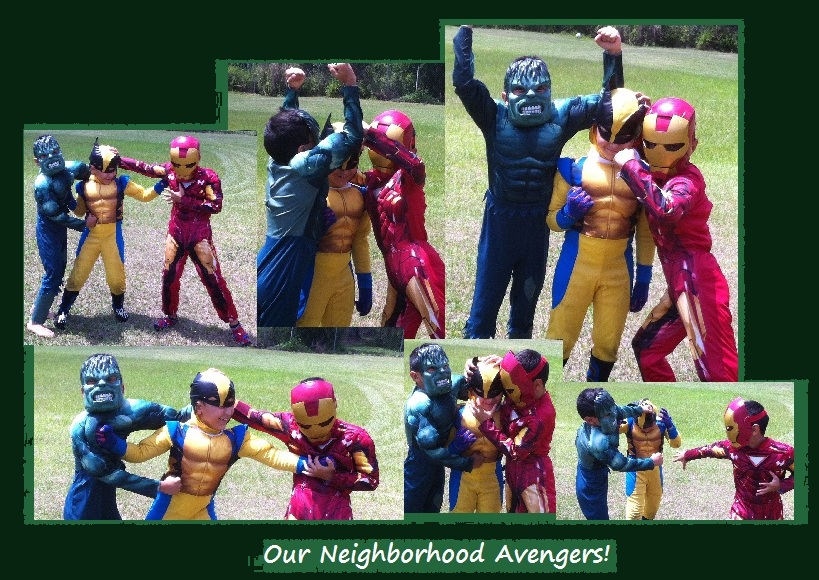
I climbed back into my van amidst my little girls’ giggles (pretty sure they were laughing more at me for taking pictures of the neighbors rather than laughing at the boys’ antics). As we headed off on our afternoon errands, I thought about how the world has changed, but children haven’t. Yes, over time the world will do its share of influencing or corrupting, as the case may be, but children are born children just like they have been since the beginning of time.
Every child is born a fresh, new, open book with pages and pages waiting to be filled.  Everything is new. Every day is an adventure. Every experience is an opportunity for discovery. Whether they’re boys or girls, whether they have average or advanced or impaired cognitive or motor abilities, whether they’re Asian or Caucasian, Black or Middle Eastern, Hispanic or (as a growing number are worldwide) a unique blend of races and ethnicities, they all start out the same…brand-new, innocent, precious beyond compare.
Everything is new. Every day is an adventure. Every experience is an opportunity for discovery. Whether they’re boys or girls, whether they have average or advanced or impaired cognitive or motor abilities, whether they’re Asian or Caucasian, Black or Middle Eastern, Hispanic or (as a growing number are worldwide) a unique blend of races and ethnicities, they all start out the same…brand-new, innocent, precious beyond compare.
I am passionate about helping parents fill the first pages of their children’s lives with messages of gentle welcome, of needs met, of trust. I’m equally passionate about helping parents transition into later stages where they are simply there to offer guidance, support, and encouragement as their children begin filling the pages of their lives with their own choices, interests, and gifts.
I’ve heard it said that only those crazy enough to think they can change the world actually do change it. I honestly believe that changing the world starts at home with how we parent our children. Maybe my neighbor is right about me, after all. 🙂
*Book art via Anagram Bookshop*
Related posts:
Communication vs. Miscommunication
Playground Confessions~Look Who’s Talking!
The Measure of Success~Chinese Parents and French Parents Can’t BOTH Be Superior!
 Award-winnning author, L.R.Knost, is the founder and director of the children's rights advocacy and family consulting group, Little Hearts/Gentle Parenting Resources, and Editor-in-Chief of Holistic Parenting Magazine. Books by L.R.Knost include Whispers Through Time: Communication Through the Ages and Stages of Childhood ; Two Thousand Kisses a Day: Gentle Parenting Through the Ages and Stages ; The Gentle Parent: Positive, Practical, Effective Discipline ; and Jesus, the Gentle Parent: Gentle Christian Parenting the first four books in the Little Hearts Handbook gentle parenting series, and children’s picture books Petey’s Listening Ears and the soon-to-be-released Grumpykins series.
Award-winnning author, L.R.Knost, is the founder and director of the children's rights advocacy and family consulting group, Little Hearts/Gentle Parenting Resources, and Editor-in-Chief of Holistic Parenting Magazine. Books by L.R.Knost include Whispers Through Time: Communication Through the Ages and Stages of Childhood ; Two Thousand Kisses a Day: Gentle Parenting Through the Ages and Stages ; The Gentle Parent: Positive, Practical, Effective Discipline ; and Jesus, the Gentle Parent: Gentle Christian Parenting the first four books in the Little Hearts Handbook gentle parenting series, and children’s picture books Petey’s Listening Ears and the soon-to-be-released Grumpykins series.
One Slippery Sock & Other Silly Tools for your Parenting Toolbox
They say laughter is the best medicine. While that may be true, there are other important uses for the tincture of silliness that should not be overlooked! Here are a few:
tincture of silliness that should not be overlooked! Here are a few:
- Your two-year-old digs his heels in at bedtime in an Oscar-worthy imitation of a mule. Give the ‘one slippery sock’ routine a try. Put socks on your feet and, when you call him to head off with you to begin your bedtime routine, start slipping and sliding on one side. Just little slips and slides will do the trick, along with a good helping of parental confusion over the possible reasons you’re having so much trouble walking. Little people love slap-stick, and you can bet your dawdler will hurry along to get in on the fun!
- Your eighteen-month-old suddenly stops enjoying the novelty of tooth-brushing and locks her little jaws tighter than a bulldog latched onto a bone. Try ‘tickling the ivories.’ Brush your own teeth first, giggling and dancing around the bathroom the whole time like you’re tickled at being tickled (while your little one watches, of course). Then release the gentle tooth-tickler on your most likely already giggling baby and say, “Tickle teeth! Tickle teeth!” while brushing those pearly whites.
- Your three-year-old eschews the use of shoes no matter how many choices of style and color you offer. Try the ‘superhero’ approach. Instead of the tired, old, “Time to get your shoes on,” routine…say, “The terrible-toe-tickling super villain is on the loose! We need some superhero armor on those feet, quick!” Be prepared to take the time to discuss the relative protective qualities of the available ‘armor’, but then get those toes to safety!
- Your six-year-old chatterbox could make a monk revoke his vow of silence just to say “Shhhhhh!!!” Try the ‘seven super silly seals sent slippery slippers to their sisters’ treatment. Give your little chatterbox a tongue-tying-twisty-treat and the promise of your full attention for five minutes when she thinks she’s ready to say it ten times fast. Then enjoy your two minutes of quiet until she returns!
- Your nine- and seven-year-olds are at each other like cats with their tails tied together. How about a ‘bag on your head while you listen to the ‘he said/she said’? When you head in to break up the gazillionth argument of the day, slip a paper bag with a great big goofy smile and a couple of googly eyes drawn on it over your head first. It may not solve everything, but it’ll be super hard for them to stay mad at each other, and a little levity might just diffuse the tension!
- Your high-schooler is one stressed-out teen with SATs looming, homework mounting, friend drama annoying, and hormones swirling. It’s time for a ‘pajama-night-out-orama’! Wait until the house settles, everyone’s in bed for the night, and all is quiet…then leave your spouse in charge of the house while you sneak your teen out the back door with you for a one-on-one run through Dunkin’ Donuts and sit in the car in your driveway stuffing your faces and letting her unstuff all the angst that’s been building up inside of her. Might not be good for your arteries, but it’ll do her heart a world of good!
Silly works! Don’t handicap your parenting by forgetting one of the most powerful tools in your parenting toolbox.
Related posts:
Babes and Boundaries~A Gentle Parenting Perspective
Parenting in Public: Toddler Time
 Award-winnning author, L.R.Knost, is the founder and director of the children's rights advocacy and family consulting group, Little Hearts/Gentle Parenting Resources, and Editor-in-Chief of Holistic Parenting Magazine. Books by L.R.Knost include Whispers Through Time: Communication Through the Ages and Stages of Childhood ; Two Thousand Kisses a Day: Gentle Parenting Through the Ages and Stages ; The Gentle Parent: Positive, Practical, Effective Discipline ; and Jesus, the Gentle Parent: Gentle Christian Parenting the first four books in the Little Hearts Handbook gentle parenting series, and children’s picture books Petey’s Listening Ears and the soon-to-be-released Grumpykins series.
Award-winnning author, L.R.Knost, is the founder and director of the children's rights advocacy and family consulting group, Little Hearts/Gentle Parenting Resources, and Editor-in-Chief of Holistic Parenting Magazine. Books by L.R.Knost include Whispers Through Time: Communication Through the Ages and Stages of Childhood ; Two Thousand Kisses a Day: Gentle Parenting Through the Ages and Stages ; The Gentle Parent: Positive, Practical, Effective Discipline ; and Jesus, the Gentle Parent: Gentle Christian Parenting the first four books in the Little Hearts Handbook gentle parenting series, and children’s picture books Petey’s Listening Ears and the soon-to-be-released Grumpykins series.
Babes and Boundaries~A Gentle Parenting Perspective
[Reprinted from Two Thousand Kisses a Day: Gentle Parenting Through the Ages and Stages by L.R.Knost. Whispers Through Time: Communication Through the Ages and Stages of Childhood also now available on Amazon]
 Parenting is soooo tiring and frustrating at times. Sometimes you just want to sit a small child down and say, “Do you know how much easier your life (and mine!) would be if you’d just be REASONABLE?!?” But we know that wouldn’t do any good because the words ‘reasonable’ and ‘toddler/preschooler’ just don’t play well together. The thing to remember is that gentle parenting doesn’t mean parenting without boundaries.
Parenting is soooo tiring and frustrating at times. Sometimes you just want to sit a small child down and say, “Do you know how much easier your life (and mine!) would be if you’d just be REASONABLE?!?” But we know that wouldn’t do any good because the words ‘reasonable’ and ‘toddler/preschooler’ just don’t play well together. The thing to remember is that gentle parenting doesn’t mean parenting without boundaries.
Believe it or not, the foundation for discipline (guiding, leading, teaching…NOT punishment ) begins in the newborn and infancy stages. When parents respond quickly, consistently, and gently to their baby’s cries, the trust relationship that the parent is establishing becomes the cornerstone for later discipline. Boundaries need to be established for a child’s safety and growth into a successful citizen of our world. A child who is secure in the knowledge that he doesn’t have to fight to be heard or to have his needs met is more open and adaptable to limits. And when the ‘limit-setter’ is a person the child trusts, the enforcement of those boundaries becomes a matter of connection and communication instead of conflict and struggle.
So, what might setting and enforcing boundaries using gentle parenting look like in real life? Here are a few examples:
- Your 18 month old has begun hitting you whenever you try the ‘remove and distract’ method of keeping her from sticking things into power outlets. In addition to covering the outlets with safety covers, a gentle parenting approach to hitting at this age would be to gently hold your child’s hand when she tries to hit, look her in the eye, and say quietly and firmly, “Gentle” or “Gentle hands,” while stroking your cheek with her hand. This sets a boundary that hitting is not okay while demonstrating what behavior is acceptable. Don’t expect this to be a one-time deal, though. Little ones learn through consistent and patient repetition.
- Your 2 year old drops to the ground in limp protest every time you try to leave ANYWHERE! First, giving a toddler some warning that a change is about to occur respects their often intense interest in and focus on their own activities. A gentle parenting approach might be to utilize the ‘countdown to leaving’ method to give them a time context (i.e. “Five more minutes! That means you have enough time for five more horsey rides on grandpa’s back!”… “Four more minutes! That means you can have four more jumps into the ballpit!”… “Three more minutes! That means you have enough time to build three more towers and knock them down!”… “Two minutes left! That means you have enough time to go down the slide two more times!”… “One more minute! That means you can look at one more book!”). Remember, children aren’t little robots we can just upload the right program into and expect it to work perfectly every time, so when your little human still impersonates a limp noodle despite your best efforts, quietly acknowledge his distress, “It’s hard to leave when you’re having fun, isn’t it?” and then gently pick him up and move him to the car/stroller, etc.
- Your 3 year old flat out refuses to wear shoes, period. In addition to giving choices, “Do you want to wear the red boots or the blue sneakers today?” and offering her the opportunity to assert her independence, “Would you like to put your shoes on yourself or do you want mommy to help?” sometimes all that is needed is a simple question, “Why don’t you want to wear shoes?” Three year olds are typically becoming articulate enough that, if they aren’t already stressed, they can do a pretty good job of explaining themselves. You might be surprised to hear something like, “Tomowow my boos hut my toes,” which when translated means, “The last time I wore my boots they hurt my feet, and now I think all shoes will hurt me.” Moving on to a more verbal communication stage of your relationship with your child when they’re ready might seem a no-brainer, but parents often get caught up in patterns of parenting from previous stages and it just doesn’t occur to them to simply ask their child what’s wrong. Again, this won’t always work, so when your little bohemian still rejects all things soled, calmly let her know that she will remain in the stroller/sling/cart and not do any walking until she decides she’s ready to put on her shoes.
One other note about parental boundaries is that it’s not just your children who will challenge them! Everyone and their mother (or especially their mother!) will take every ‘misbehavior’ by your child as an opportunity to give you unsolicited and often unwanted advice. Remember, when it comes down to it, it’s you, the parent, who determines what limits to set. Mrs. In-My-Day, Cousin Know-It-All, Mr. My-Way-Is-The-Only-Way, and Neighbor Nose-In-Everyone-Else’s-Business all have their own ideas that make sense to them, and that’s fine, but you are not them! You the unique parent of a unique individual, and you have the sole responsibility to raise that individual as you see fit (with reasonable limits set by your community as to what constitutes abuse, neglect, etc).
Everyone and their mother (or especially their mother!) will take every ‘misbehavior’ by your child as an opportunity to give you unsolicited and often unwanted advice. Remember, when it comes down to it, it’s you, the parent, who determines what limits to set. Mrs. In-My-Day, Cousin Know-It-All, Mr. My-Way-Is-The-Only-Way, and Neighbor Nose-In-Everyone-Else’s-Business all have their own ideas that make sense to them, and that’s fine, but you are not them! You the unique parent of a unique individual, and you have the sole responsibility to raise that individual as you see fit (with reasonable limits set by your community as to what constitutes abuse, neglect, etc).
In practical application, boundaries do reflect the culture and environment in which a child lives. In a small, rural community in Spain, doors may be left open day and night and the neighbors may all be related. Small children might have the freedom to wander in and out of houses, play ball in the middle of the road, and plop down for an afternoon nap on a neighbor’s sofa. In a busy, urban city such as New York, doors may be kept locked, people may never have even met their neighbors, and playing in the street might be tantamount to a child endangerment charge.
The point is that boundaries aren’t a one-size-fits-all list that you can buy from Barnes & Noble, put on the fridge, and slap a sticker on every time a child complies. Boundaries are personal limits determined by the parent’s values and priorities and culture as well as reflecting the age and maturity of their child and the unique attributes of their community.
It may ‘take a village’ to raise a child, but remember, it’s you, the parent, who’s the leader of your tribe!
Related posts:
Testing the Boundaries~What’s A Parent To Do?
Toddlers, Tantrums, and Time-Ins, Oh My!
The Taming of the Tantrum: A Toddler’s Perspective
 Award-winnning author, L.R.Knost, is the founder and director of the children's rights advocacy and family consulting group, Little Hearts/Gentle Parenting Resources, and Editor-in-Chief of Holistic Parenting Magazine. Books by L.R.Knost include Whispers Through Time: Communication Through the Ages and Stages of Childhood ; Two Thousand Kisses a Day: Gentle Parenting Through the Ages and Stages ; The Gentle Parent: Positive, Practical, Effective Discipline ; and Jesus, the Gentle Parent: Gentle Christian Parenting the first four books in the Little Hearts Handbook gentle parenting series, and children’s picture books Petey’s Listening Ears and the soon-to-be-released Grumpykins series.
Award-winnning author, L.R.Knost, is the founder and director of the children's rights advocacy and family consulting group, Little Hearts/Gentle Parenting Resources, and Editor-in-Chief of Holistic Parenting Magazine. Books by L.R.Knost include Whispers Through Time: Communication Through the Ages and Stages of Childhood ; Two Thousand Kisses a Day: Gentle Parenting Through the Ages and Stages ; The Gentle Parent: Positive, Practical, Effective Discipline ; and Jesus, the Gentle Parent: Gentle Christian Parenting the first four books in the Little Hearts Handbook gentle parenting series, and children’s picture books Petey’s Listening Ears and the soon-to-be-released Grumpykins series.
Testing the Boundaries~What’s A Parent To Do?
 [Portions reprinted from The Gentle Parent: Positive, Practical, Effective Discipline by L.R.Knost. Two Thousand Kisses a Day: Gentle Parenting Through the Ages and Stages and Whispers Through Time: Communication Through the Ages and Stages of Childhood now available on Amazon and through other major retailers.]
[Portions reprinted from The Gentle Parent: Positive, Practical, Effective Discipline by L.R.Knost. Two Thousand Kisses a Day: Gentle Parenting Through the Ages and Stages and Whispers Through Time: Communication Through the Ages and Stages of Childhood now available on Amazon and through other major retailers.]
Challenging behavior in our children can be really…well, challenging! How do you ‘handle’ a child who suddenly refuses to wear shoes or sit in her carseat/seatbelt or eat, period? Here are some tips to help you regain that snuggly, loving relationship you used to enjoy before your baby became a…gulp…PERSON!
1.) Remove the word ‘handle’ from your parenting vocabulary entirely. Your child isn’t a lion to be tamed or a dog to be trained! He’s a person, an individual with thoughts, interests, concerns, wants, and needs that are totally separate from yours. Respecting him as a separate individual not only models the value we need to place on others in our homes and communities, but also sets the stage for a mutually respectful relationship in his teen years and beyond.
2.) Slow down! Often simplifying our lives is the key to simplifying our parenting issues. Rushing a child from one activity to the next doesn’t expand her horizons; it stunts her creativity and inherent zest for life, which are the building blocks of a life-long love of learning. When she digs her heels in, pay attention! She’s trying to communicate a very deep need for time and space to learn about the world, to play and grow, and to just ‘be.’
3.) Small children have very little control over their lives, and the more powerless they feel, the more likely they are to make eating, getting dressed, going to the potty, etc. a battle of wills. Giving choices, engaging your child in making plans, and being flexible and responsive on a daily basis are good ‘proactive’ parenting, but little people are notorious for their awkward timing in deciding to suddenly assert their independence! Be prepared for those challenging moments by deciding ahead of time how you will respond. (See below for some ideas!)
4.) Listen, listen, listen! The first question parents ask me is almost always, “How do I get my child to listen?” And my first response is usually, “How well do you listen?” As Ralph Waldo Emerson so aptly put it, “What you do speaks so loud that I cannot hear what you say.” In other words, our children learn best by imitation. If every time our little ones ask for our attention we say, “Just a minute,” then we cannot expect instant attention from them. If when they speak to us our eyes constantly stray back to our computers and iPhones, we should not be surprised if they have a hard time looking at us when we ask them to. Listening is a two-way street that starts and ends with us, the adults.
5.) Boundaries are our friends! Many people believe that Gentle Parenting is a form of un-parenting, but nothing could be further from the truth. Gentle Parenting is involved parenting~interactive, engaged, active parenting. It takes focused attention, planning, participation, research, and so much more to be an empathetic, responsive parent who is in tune with their child’s needs and who is prepared to make whatever sacrifices are necessary to meet those needs. That said, in any home, like in any civilized society, boundaries are necessary for everyone’s safety and comfort. It is in the choosing and maintaining of those boundaries that Gentle Parenting distinguishes itself. In a gently parented home, boundaries are focused on guiding rather than controlling children and are maintained through empathetic and creative resolutions rather than harsh punitive consequences. (See below for some ideas!)
6.) Watch your attitude! Do you have angry eyes? A sharp tone? Do you issue commands and demand compliance? Do you sigh and roll your eyes when frustrated with your little one? All of these things contribute to creating resistance in children. Really, who wants to cooperate with someone who is demanding, impatient, sarcastic, angry, etc? Does feeling like a burden or a failure ever motivate anyone? Is a desire to please rooted in correction or connection? Think about how you like to be treated by authority figures (supervisors, law enforcement, etc.) and then treat your children the way you want to be treated! This not only reduces challenging behavior, but also models The Golden Rule~Do to others as you want them to do to you…an excellent life lesson!
Here are some ideas for your Gentle Parenting toolbox:
- Little one refusing to put on shoes before leaving the house? First, ask him why he doesn’t want to wear them. A toddler most likely won’t be able to/want to explain, but you’re modeling courtesy and opening up a dialogue, both good connection points. A three-year-old, though, might just surprise you with a very logical, in their own mind at least, response! Second, don’t react; just scoop the shoes up, and take them with you. If the refusal to wear shoes continues at the park/in the library/at the doctor’s office, etc. calmly tell him he can sit in your lap or in the stroller and hang out with you until he’s ready to wear his shoes.
- If a tantrum results, remember to stay calm (deep breathing, counting silently, and saying a quick prayer for guidance are all helpful!) and remain present. Some children respond well to a parent quietly talking, offering words to express what the child may be experiencing (i.e. “It’s frustrating when we have to do things we don’t like. I can see that you’re angry, and that’s okay. Let’s just sit here together for a while.”), while other children become more upset when a parent attempts to interact with them during a tantrum and are comforted simply by your quiet presence, a gentle back rub, or playing with a Calm-Me-Jar . Getting to know your child is an important part of Gentle Parenting and will help you to ‘read’ these situations so you can be responsive to their unique needs.
- A place for Time-Outs. Typically, I advise parents to use Time-Ins instead of Time-Outs in order to connect-to-correct, but there is one area that I advise the use of Time-Outs…the ‘Time-Out Toy Box!’ When a toy is misused (i.e. thrown, used to
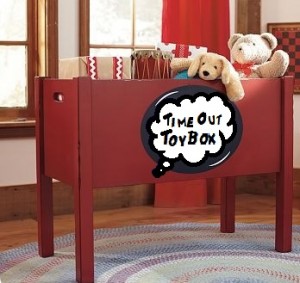 hit, drawn on, fought over, etc) and a gentle redirection has been given, the next step for the toy is to be put in the ‘Time-Out Toy Box.’ Little ones generally find the concept of a toy being put in Time-Out rather humorous and go along with the removal without a fuss (the toy can be returned after an exaggeratedly stern warning to the toy letting it know what is expected of it and that it must listen to ‘the boss’ ~the child, lol. They love that!), but remember to communicate, listen, and be flexible. If the removal of a toy brings about a strong negative response, it may be that the inappropriate behavior was more than just over-exuberance, in which case a Time-In might be needed. Again, being in tune with your child will help you to ‘read’ the situation and respond appropriately.
hit, drawn on, fought over, etc) and a gentle redirection has been given, the next step for the toy is to be put in the ‘Time-Out Toy Box.’ Little ones generally find the concept of a toy being put in Time-Out rather humorous and go along with the removal without a fuss (the toy can be returned after an exaggeratedly stern warning to the toy letting it know what is expected of it and that it must listen to ‘the boss’ ~the child, lol. They love that!), but remember to communicate, listen, and be flexible. If the removal of a toy brings about a strong negative response, it may be that the inappropriate behavior was more than just over-exuberance, in which case a Time-In might be needed. Again, being in tune with your child will help you to ‘read’ the situation and respond appropriately.
- The most challenging, independent children tend to be the ones who need the most intentional parental reconnection. Strong will=Strong need! It is often the strongest-willed children who identify most closely with their parents, oddly enough. While there is no denying how difficult it can be to raise a strong-willed child, seeing the purpose behind the behavior can make the journey much more manageable. Try to view their seemingly constant testing as them doing ‘research’ on you, seeing where your strengths and weaknesses are, and discovering all the ins and outs of being you. Also, taking the time to explain why you make the decisions you do, why you said this, why you didn’t say that, answering the endless questions patiently and openly, can alleviate some of the challenging behavior by offering them insights into who you are without them having to ‘dig’ it out of you!
Related posts:
Practical, Gentle, Effective Discipline
The Taming of the Tantrum: A Toddler’s Perspective
When Children Hit~10 Tips for Parents
Easy Peasy DIY Parenting Tools
To a Toddler Sharing is a 4 Letter Word~MINE!
Tots to Teens~Communication through the Ages and Stages
Parenting in Public: Toddler Time
 Award-winnning author, L.R.Knost, is the founder and director of the children's rights advocacy and family consulting group, Little Hearts/Gentle Parenting Resources, and Editor-in-Chief of Holistic Parenting Magazine. Books by L.R.Knost include Whispers Through Time: Communication Through the Ages and Stages of Childhood ; Two Thousand Kisses a Day: Gentle Parenting Through the Ages and Stages ; The Gentle Parent: Positive, Practical, Effective Discipline ; and Jesus, the Gentle Parent: Gentle Christian Parenting the first four books in the Little Hearts Handbook gentle parenting series, and children’s picture books Petey’s Listening Ears and the soon-to-be-released Grumpykins series.
Award-winnning author, L.R.Knost, is the founder and director of the children's rights advocacy and family consulting group, Little Hearts/Gentle Parenting Resources, and Editor-in-Chief of Holistic Parenting Magazine. Books by L.R.Knost include Whispers Through Time: Communication Through the Ages and Stages of Childhood ; Two Thousand Kisses a Day: Gentle Parenting Through the Ages and Stages ; The Gentle Parent: Positive, Practical, Effective Discipline ; and Jesus, the Gentle Parent: Gentle Christian Parenting the first four books in the Little Hearts Handbook gentle parenting series, and children’s picture books Petey’s Listening Ears and the soon-to-be-released Grumpykins series.
Jesus, The Gentle Parent
[Excerpt reprinted from Jesus, the Gentle Parent: Gentle Christian Parenting by L.R.Knost. Two Thousand Kisses a Day: Gentle Parenting Through the Ages and Stages; Whispers Through Time: Communication Through the Ages and Stages of Childhood; and The Gentle Parent: Positive, Practical, Effective Discipline by L.R.Knost also available on Amazon and through other major retailers.]
~~~~~~~~~~~~~~~~~~~~~
Jesus, the Gentle Parent
“…a great and powerful wind tore the mountains apart and shattered the rocks before the Lord,
but the Lord was not in the wind. After the wind there was an earthquake,
but the Lord was not in the earthquake.
After the earthquake came a fire,
but the Lord was not in the fire.
And after the fire came
a gentle whisper…”
1 Kings 19:11-12
God has gone to great lengths, superhuman lengths even, to reach out to his wandering children and call them home, back into the safe shelter of his arms, into the warm welcome of his presence, into the tender delight of his heart.
Throughout the Old Testament, he spoke through prophets, dreams, angels, and even a bush! He revealed his character in his ‘commandments’ (in the original Hebrew text ‘tsawah’ which literally means ‘directions’ or ‘guides’) and in the names he called himself and in his interactions with that lovely, stubborn, chosen nation, Israel.
And, finally, in the New Testament, he just stuck his feet right in the dirt and somehow stuffed his infinite Being  into the skin of a human.
into the skin of a human.
God with us.
GOD. With. Us!
Why in Heaven’s name would he do that? Well, that’s been the subject of dusty tomes and esoteric debates for centuries, but in truth the answer is very simple: God is a father, a daddy who wants to connect with and build a relationship with his children.
In the Old Testament God revealed himself as a father who is Creator, Provider, and Protector. He showed himself to be an involved father, interested in every detail of his children’s lives, from what they ate to how and where and when they worshiped him. And he revealed his purity, his incomprehensible holiness that kept his beloved children hopelessly separated from him and helpless to change that fact. All the rules for cleansing, all the rituals, and all the formulas, only served to highlight the pitiful fallen state of God’s beloved children.
Then, in the New Testament, God stepped in. He stepped out of Heaven, and he stepped into the muck and mire of life among his precious children.
And that ritualistic, external, temporal cleansing? It became relational, internal, and eternal.
Stones once thrown in righteous judgment were laid down in humble mercy. Punishment was replaced with grace as Righteousness Himself stood between sinful man and his dire fate.
And so we have Jesus, God Himself with us in the flesh, God’s heart in a very literal sense laid bare for all the world to see, the perfect Parent to model ourselves after.
We have the Father…not a father, but THE Father…to look to for guidance about how to parent our children.
So, let’s get practical. What does God’s parenting look like, and how can we model ourselves after him?
Well, Jesus raised twelve children, so let’s take a look at how he did it!
Twelve of God’s children, all with different personalities, backgrounds, and talents, became Jesus’ disciples. The word disciple is the root word in discipline, so in a completely literal sense to discipline our children means to disciple them.
So, what characteristics defined Jesus’ discipleship? How did he treat his disciples? Was he harsh? Did he yell? Did he punish them? Clearly, he had the authority to! But since he came to free us from punishment, it really wouldn’t make sense for him to start meting it out, would it?
Was he distant, unresponsive to their needs? Did he make demands, insist on instant obedience, and toss around kingly commands?
No, no, no, and no! Jesus treated his disciples gently, tenderly. He listened. He responded to their needs, answered their questions, spoke their language. Jesus encouraged and guided and taught his disciples.
He drew them close to himself, lived with them, ate with them, travelled with them. Jesus didn’t just say he loved his disciples. He didn’t simply feel love for his disciples. Jesus lived love for his disciples. And he lived that love daily, mercifully, sacrificially.
So, what are the characteristics that defined Jesus’ discipleship?
Gentle. Tender. Responsive. Available.
Listening. Encouraging. Teaching. Guiding.
God, himself, intimately and empathetically connecting with his children.
That is perfect parenting.
 I, however, am NOT a perfect parent. In the time it’s taken me to write this so far, I’ve failed at pretty much every single one of those perfect parenting qualities. I only say that to point out that we aren’t shooting for perfection here.
I, however, am NOT a perfect parent. In the time it’s taken me to write this so far, I’ve failed at pretty much every single one of those perfect parenting qualities. I only say that to point out that we aren’t shooting for perfection here.
If perfection were possible, the Cross wouldn’t have been necessary. (Galatians 2:21)
I have failed and will fail again as a parent. But even my failures have great value because they lead me back to the Cross, time and time again.
My failures remind me to turn to my perfect Parent, God, and trust him with my children. And my failures offer me the opportunity to be transparent with my children, to ask for forgiveness, to show them it’s okay to be human and to make mistakes.
In short, my imperfections are perfect for demonstrating God’s unconditional love.
So, what are some ways we can reflect Christ-like qualities in our never-perfect-but-best-effort parenting?
- Build your relationship. Everything, absolutely everything, in raising children is dependent upon a secure parent/child relationship, and the foundation is trust. We talk all the time in Christian circles about needing to trust God more. Why? What’s so important about trust? Trust is the secure knowledge that we will be cared for, that the person we are dependent on is who they say they are and will do what they say they will do. Without trust, there is no relationship. You build trust in your children starting from day one by responding faithfully and quickly to their needs, day or night, even if their ‘need’ is simply reassurance that you’re there.
- Be there in the moment. This isn’t about quality time or quantity time. This is about actually being with your children when you’re with them. I’m talking about muting the television and making sustained eye contact all the way through the story of how they had the piece of string first and how it was taken by a sibling when they only set it down for a minute and…well, you get the picture. Jesus showed he cared by listening and responding to what was important and relevant to his children. Even when he was sound asleep on the boat, when his children cried out to him in fear, Jesus responded to their needs, soothed his children, and calmed the storm.
- Encourage, don’t discourage. Jesus built up his disciples, giving positive directions, allowing time and opportunity for them to try, helping when they needed it, and forgiving them when they failed. Never, not once, did he lash out at his disciples in anger. He taught them gently and encouragingly, often in stories that related to their daily lives, and he was always available to discuss or clarify or answer questions.
- Practice what you preach. This is foundational, right along with trust. If you don’t live out how you want your children to turn out, you can be pretty much guaranteed they’ll go an entirely different way. Listen to your children if you want them to learn to listen. Respect your children if you want them to learn respect. Model compassion, kindness, honesty, forgiveness, and a grateful spirit if you want your children to grow into adults with those character traits. Jesus certainly lived out every one of those qualities for his children.
- Don’t make excuses. If you fail (and you will) apologize. Nothing penetrates hurt more deeply and with more healing power than an honest, open apology.
- Give grace. The unconditional love of God is beyond human comprehension. Even ‘veteran’ Christians resort to trying to earn God’s grace when they’ve already been given it freely. We all fall into that trap, time and time again, because we just can’t wrap our human brains around something as awesomely simple as unconditional love. We think it MUST be more complicated, and we end up complicating it by trying to pay for something that is free! So, help your children while they’re looking to you, their earthly parent, for an example of how their Heavenly Parent operates. Give them grace. Guide them gently. Forgive them when they fall, and get down on their level to help them back up again.
- Enjoy your blessings. Your children are a reward, a blessing, a gift straight from the heart of your Father to you, his precious child. He wants you to feel what he feels, to experience him in a unique way through parenting your children in the way that he parents you. He wants you to delight in your children so you’ll understand how he delights in you. He wants you to feel the depth of concern he feels when you stray into danger, the heights of joy he feels when you run trustingly into his arms, the pangs of compassion he feels when you are hurting or scared. Take the time to enjoy your children, and you will find yourself closer to the heart of your Father than you can possibly imagine.
“Whoever receives one of these little children in My name receives Me;
and whoever receives Me, receives not Me but Him who sent Me.”
Mark 9:37
Related links:
Stealing God’s Gift: Free Will is a Gift to be Nurtured, Not a Curse to be Broken
Spare the Rod: The Heart of the Matter
Did Jesus Have a Temper Tantrum?
Jesus, the Gentle Parent: Gentle Christian Parenting
Tattered Tapestries: Weaving Trust Through the Chaos
Fear Doesn’t Lead to Faith: Becoming Your Child’s Safe Place
Where Did You Learn Love, Child?
Practical, Gentle, Effective Discipline
 Award-winnning author, L.R.Knost, is the founder and director of the children's rights advocacy and family consulting group, Little Hearts/Gentle Parenting Resources, and Editor-in-Chief of Holistic Parenting Magazine. Books by L.R.Knost include Whispers Through Time: Communication Through the Ages and Stages of Childhood ; Two Thousand Kisses a Day: Gentle Parenting Through the Ages and Stages ; The Gentle Parent: Positive, Practical, Effective Discipline ; and Jesus, the Gentle Parent: Gentle Christian Parenting the first four books in the Little Hearts Handbook gentle parenting series, and children’s picture books Petey’s Listening Ears and the soon-to-be-released Grumpykins series.
Award-winnning author, L.R.Knost, is the founder and director of the children's rights advocacy and family consulting group, Little Hearts/Gentle Parenting Resources, and Editor-in-Chief of Holistic Parenting Magazine. Books by L.R.Knost include Whispers Through Time: Communication Through the Ages and Stages of Childhood ; Two Thousand Kisses a Day: Gentle Parenting Through the Ages and Stages ; The Gentle Parent: Positive, Practical, Effective Discipline ; and Jesus, the Gentle Parent: Gentle Christian Parenting the first four books in the Little Hearts Handbook gentle parenting series, and children’s picture books Petey’s Listening Ears and the soon-to-be-released Grumpykins series.

 [Reprinted from
[Reprinted from 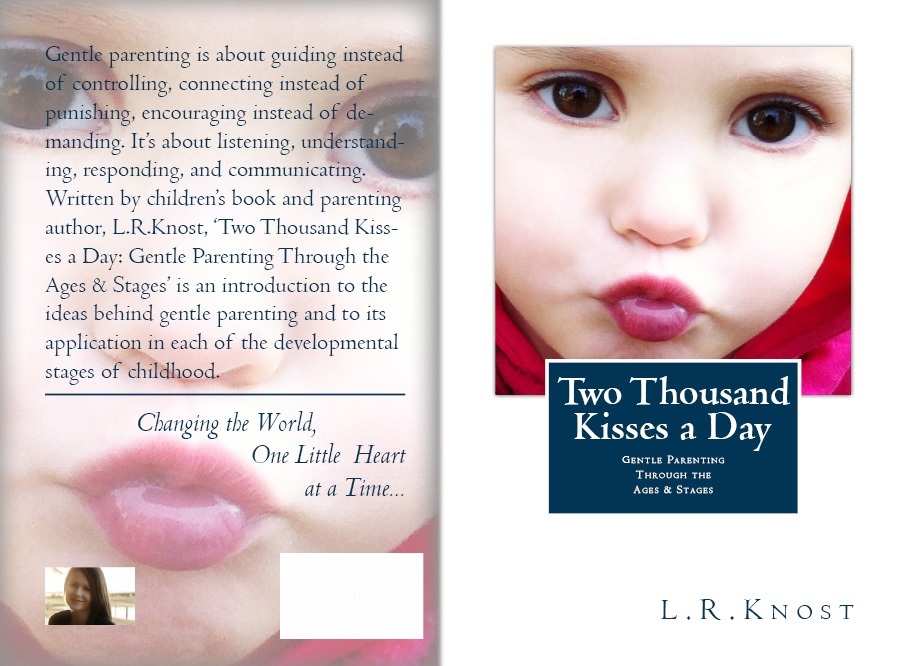
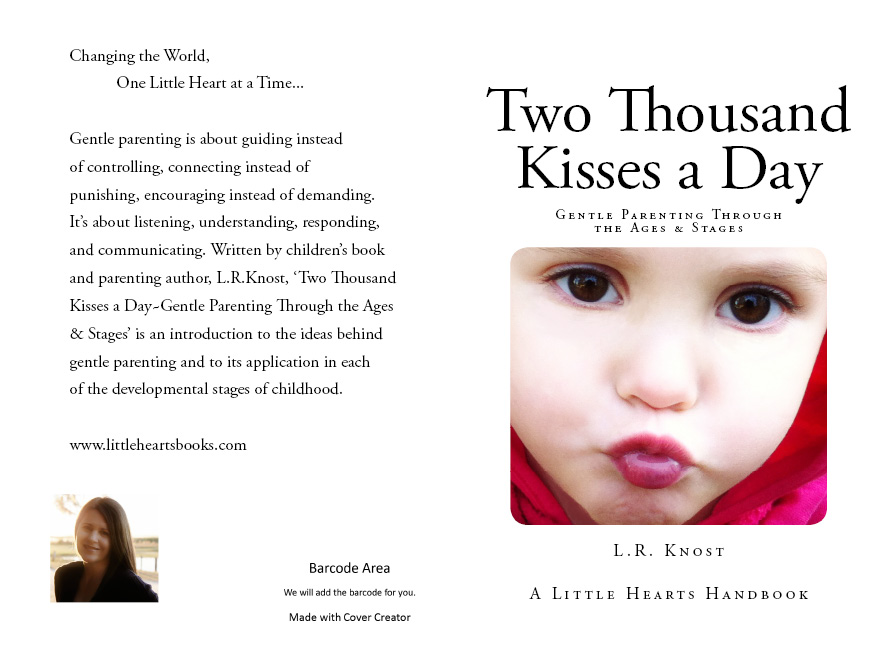
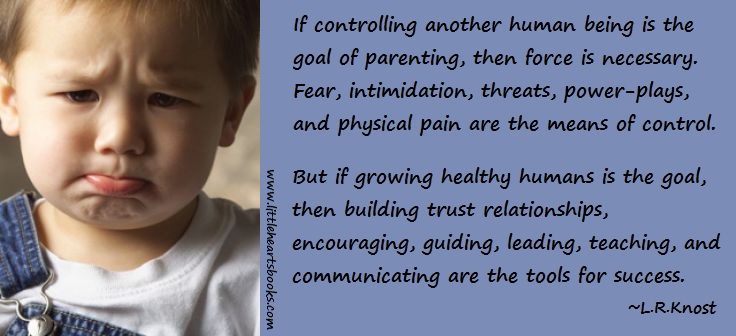


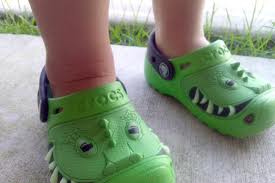














 Many people believe that gentle parenting is a form of unparenting, but nothing could be further from the truth. Gentle parenting is involved parenting ~interactive, engaged, active parenting. It takes focused attention, planning, participation, research, and so much more to be an empathetic, responsive parent who is in tune with their child’s needs and who is prepared to make whatever sacrifices are necessary to meet those needs. That said, in any home, like in any civilized society, boundaries are necessary for everyone’s safety and comfort. It is in the choosing and enforcing of those boundaries that gentle parenting distinguishes itself. In a gently parented home, boundaries are focused on guiding rather than controlling children and are enforced through empathetic and creative resolutions rather than harsh punitive consequences. If you’d like to transition to a more gentle mode of parenting, but don’t know where to start, below are links to alternatives to punishment, and here is a guide to help you set yourself up for success in your journey to gentle parenting…
Many people believe that gentle parenting is a form of unparenting, but nothing could be further from the truth. Gentle parenting is involved parenting ~interactive, engaged, active parenting. It takes focused attention, planning, participation, research, and so much more to be an empathetic, responsive parent who is in tune with their child’s needs and who is prepared to make whatever sacrifices are necessary to meet those needs. That said, in any home, like in any civilized society, boundaries are necessary for everyone’s safety and comfort. It is in the choosing and enforcing of those boundaries that gentle parenting distinguishes itself. In a gently parented home, boundaries are focused on guiding rather than controlling children and are enforced through empathetic and creative resolutions rather than harsh punitive consequences. If you’d like to transition to a more gentle mode of parenting, but don’t know where to start, below are links to alternatives to punishment, and here is a guide to help you set yourself up for success in your journey to gentle parenting…



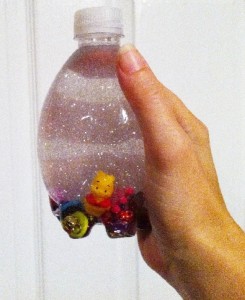





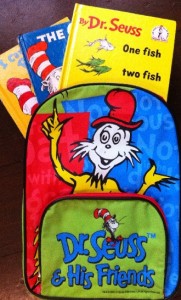


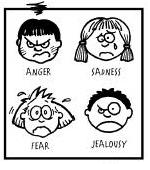

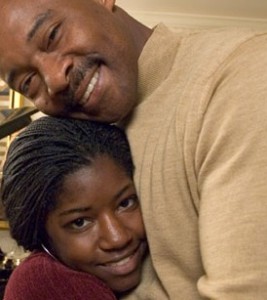







 So, your precious baby has finally arrived! After a perfect pregnancy and blissful labor and delivery, you’ve come home (in your pre-pregnancy clothes, of course!) with your beautiful baby, ready to start life as the perfect parents of a perfect child. Yeah, right! Actually, after a pregnancy in which you threw up more times than you can count and yet still managed to gain an embarrassing amount of weight, and where your feet swelled to unrecognizable lumps at the bottom of your legs, you finally suffered through a hideously long, painful labor and delivery only to arrive home (in your largest maternity outfit which barely fit!) with a screaming, vomiting, miniature human being who can’t tell you why he’s upset and who poops what can only be described as TAR! What are you going to do now?!?
So, your precious baby has finally arrived! After a perfect pregnancy and blissful labor and delivery, you’ve come home (in your pre-pregnancy clothes, of course!) with your beautiful baby, ready to start life as the perfect parents of a perfect child. Yeah, right! Actually, after a pregnancy in which you threw up more times than you can count and yet still managed to gain an embarrassing amount of weight, and where your feet swelled to unrecognizable lumps at the bottom of your legs, you finally suffered through a hideously long, painful labor and delivery only to arrive home (in your largest maternity outfit which barely fit!) with a screaming, vomiting, miniature human being who can’t tell you why he’s upset and who poops what can only be described as TAR! What are you going to do now?!?

 Sixth, birth is a huge transition for a baby. From a warm, dark, weightless environment where all their needs are met, sounds are muffled, and mama’s heartbeat lulls them to sleep, they are abruptly ejected into a cold, loud, bright world where they experience hunger and discomfort and loneliness and fear for the first time. You can help your little one cope by easing the transition for him. Keeping the lights a bit dimmer and the sounds a bit more muted right at first is helpful in welcoming your baby to your world. Also, it’s helpful to
Sixth, birth is a huge transition for a baby. From a warm, dark, weightless environment where all their needs are met, sounds are muffled, and mama’s heartbeat lulls them to sleep, they are abruptly ejected into a cold, loud, bright world where they experience hunger and discomfort and loneliness and fear for the first time. You can help your little one cope by easing the transition for him. Keeping the lights a bit dimmer and the sounds a bit more muted right at first is helpful in welcoming your baby to your world. Also, it’s helpful to 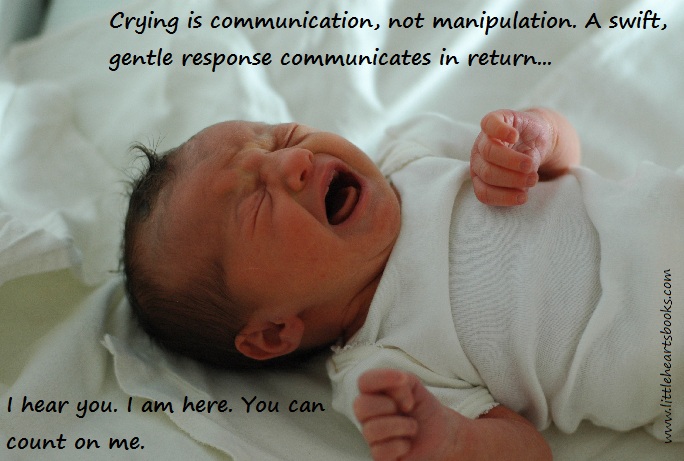 Eighth, your baby is completely and totally helpless in every way. Her main mode of communication is crying. Medical experts agree that it isn’t possible to spoil a newborn, and you are just at the beginning stages of building a trust relationship, so respond promptly to your little one’s cries! Your immediate response to your baby’s needs will help her begin to learn that she can count on you when she needs you and that she doesn’t have to ‘fight’ for your attention. Babies left to cry-it-out often do sleep through the night sooner than babies whose needs are responded to because they have learned to give up on their needs being met. But that ‘gain’ of sleeping through the night is accomplished at the ‘loss’ of trust, and the
Eighth, your baby is completely and totally helpless in every way. Her main mode of communication is crying. Medical experts agree that it isn’t possible to spoil a newborn, and you are just at the beginning stages of building a trust relationship, so respond promptly to your little one’s cries! Your immediate response to your baby’s needs will help her begin to learn that she can count on you when she needs you and that she doesn’t have to ‘fight’ for your attention. Babies left to cry-it-out often do sleep through the night sooner than babies whose needs are responded to because they have learned to give up on their needs being met. But that ‘gain’ of sleeping through the night is accomplished at the ‘loss’ of trust, and the 
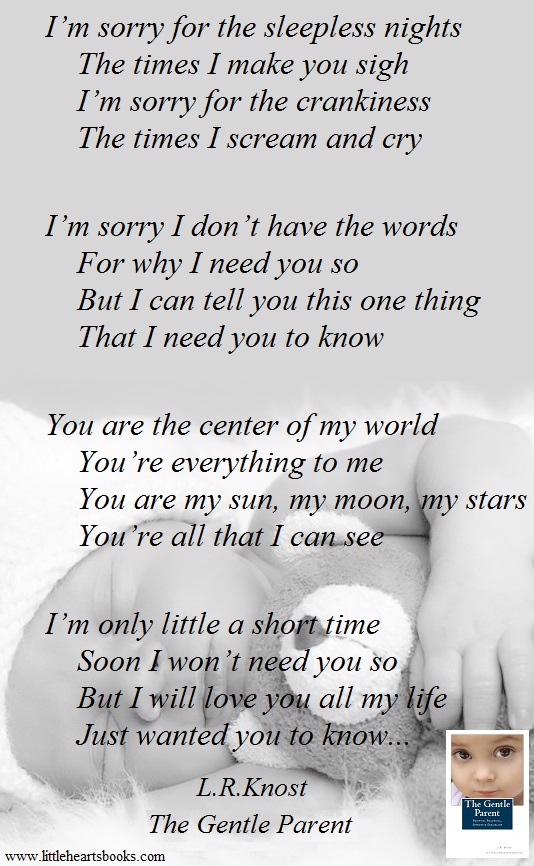 Related links:
Related links: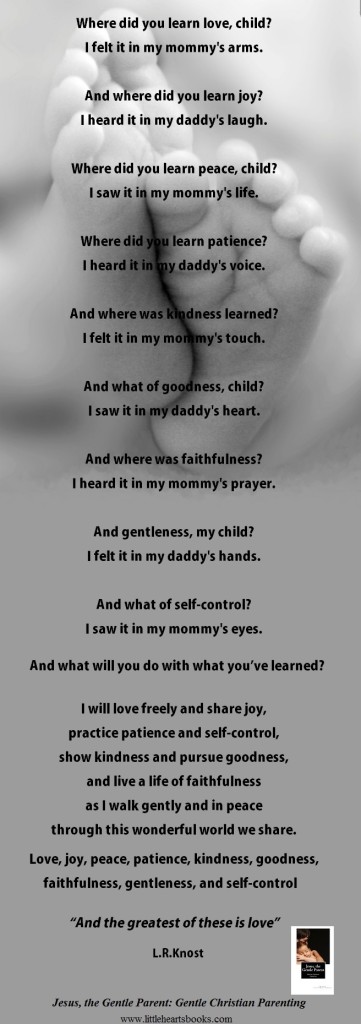
 On a recent trip to the park, I overheard a parent ranting and raving about a little one “being a brat and always pitching fits.” It took me less than two seconds of looking at the child to realize his mother had put him down on hot asphalt without shoes on, and his ‘fit’ was actually cries of pain as he danced around trying to keep his poor little feet off the asphalt while trying to push past his mommy to get back into the car. In a few years this mother will wonder why her ten-year-old is always so sullen and silent.
On a recent trip to the park, I overheard a parent ranting and raving about a little one “being a brat and always pitching fits.” It took me less than two seconds of looking at the child to realize his mother had put him down on hot asphalt without shoes on, and his ‘fit’ was actually cries of pain as he danced around trying to keep his poor little feet off the asphalt while trying to push past his mommy to get back into the car. In a few years this mother will wonder why her ten-year-old is always so sullen and silent. world, they are trying to communicate. Crying, grunting, making eye contact, mirroring expressions, all of these things are the instinctive tools built into infants to reach out into a brand new world and make contact. They can do no more. It is entirely up to the parent to make the connection, to respond, to build those all-important ‘lines of communication’ that will be so vitally important to parents in later childhood. Communication is not something that just happens. It is not something that begins when a child becomes verbal, and it’s not a product of a child’s advancing maturity. Communication is a process, a relational building block, a result of intentional and responsive parenting.
world, they are trying to communicate. Crying, grunting, making eye contact, mirroring expressions, all of these things are the instinctive tools built into infants to reach out into a brand new world and make contact. They can do no more. It is entirely up to the parent to make the connection, to respond, to build those all-important ‘lines of communication’ that will be so vitally important to parents in later childhood. Communication is not something that just happens. It is not something that begins when a child becomes verbal, and it’s not a product of a child’s advancing maturity. Communication is a process, a relational building block, a result of intentional and responsive parenting.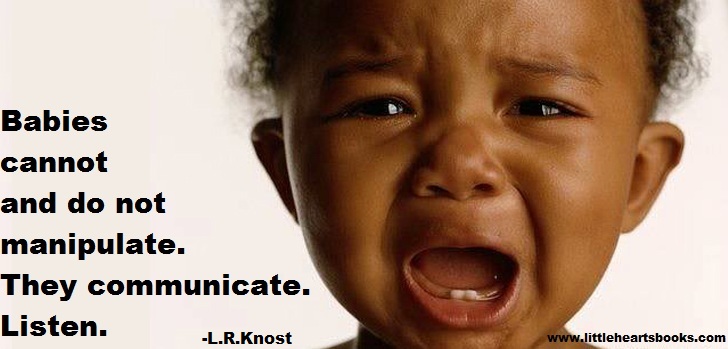 Crying is often mischaracterized as manipulation, and adults are certainly capable of using it that way. But to project such motivations on a baby is to grant them a level of skill and control far, far beyond their capabilities, and that is a potentially disastrous mistake. A parent’s perception of the motivation behind their child’s behavior is often the single most powerful determinant of the parent’s response. And the parental response or lack of response to a nonverbal child’s cries either builds or damages their communication and connection. There is no in between, no neutral.
Crying is often mischaracterized as manipulation, and adults are certainly capable of using it that way. But to project such motivations on a baby is to grant them a level of skill and control far, far beyond their capabilities, and that is a potentially disastrous mistake. A parent’s perception of the motivation behind their child’s behavior is often the single most powerful determinant of the parent’s response. And the parental response or lack of response to a nonverbal child’s cries either builds or damages their communication and connection. There is no in between, no neutral. And the responsibility for building communication and connection with your child doesn’t end when your child becomes verbal. There is a reason children aren’t classified as adults until they are, in fact, adults. They simply do not have the judgment, experience, or maturity of an adult. Parents, you are the center of your child’s world for many years, and they will model themselves after the example you set.
And the responsibility for building communication and connection with your child doesn’t end when your child becomes verbal. There is a reason children aren’t classified as adults until they are, in fact, adults. They simply do not have the judgment, experience, or maturity of an adult. Parents, you are the center of your child’s world for many years, and they will model themselves after the example you set.